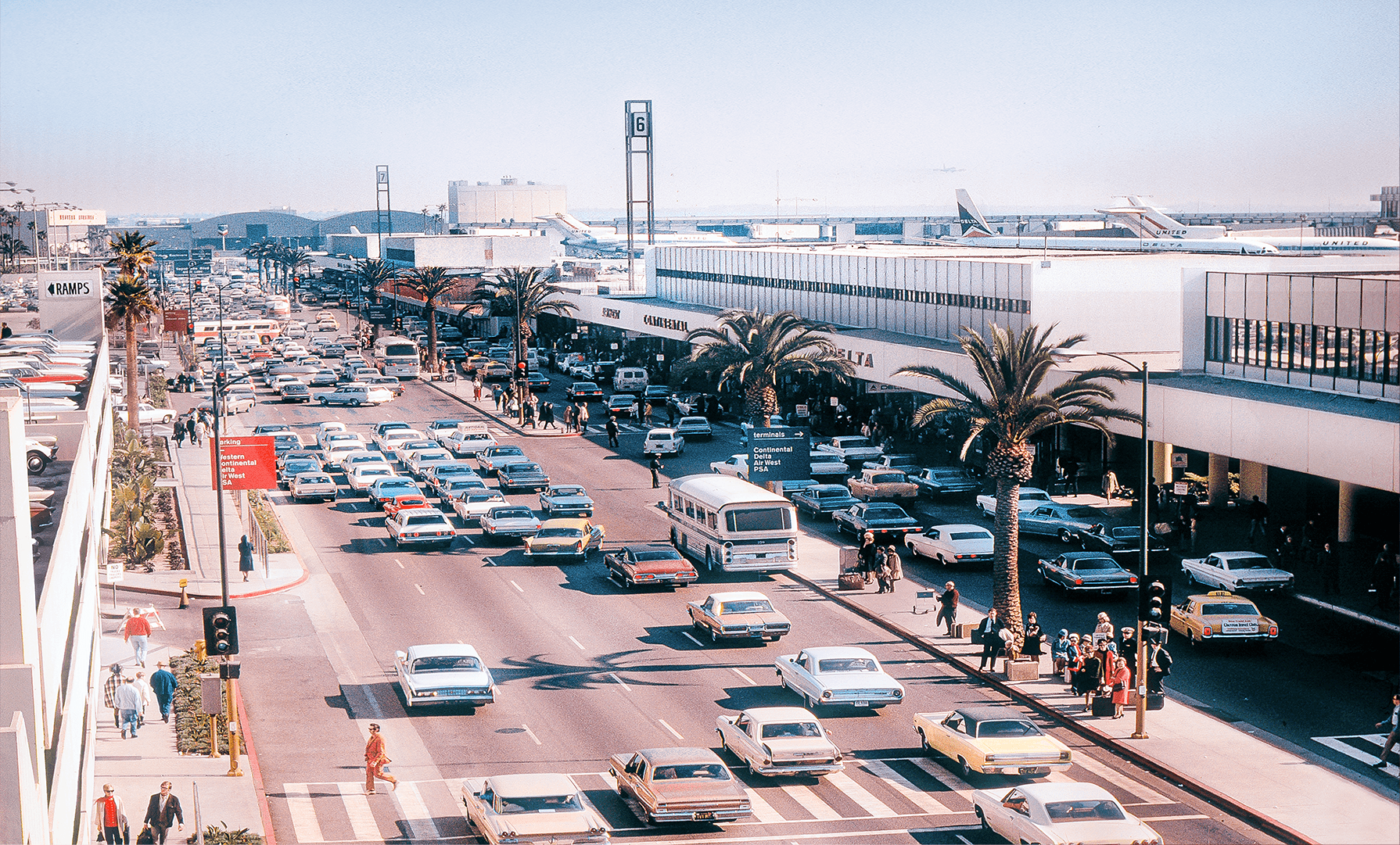
Summer traffic in the blooming era of international travel. The scores of beautiful foreign vehicles, the shadow of the palm tree on the road, the man crossing the zebra in his dashing red suit, it all looks so surreal in this scene.
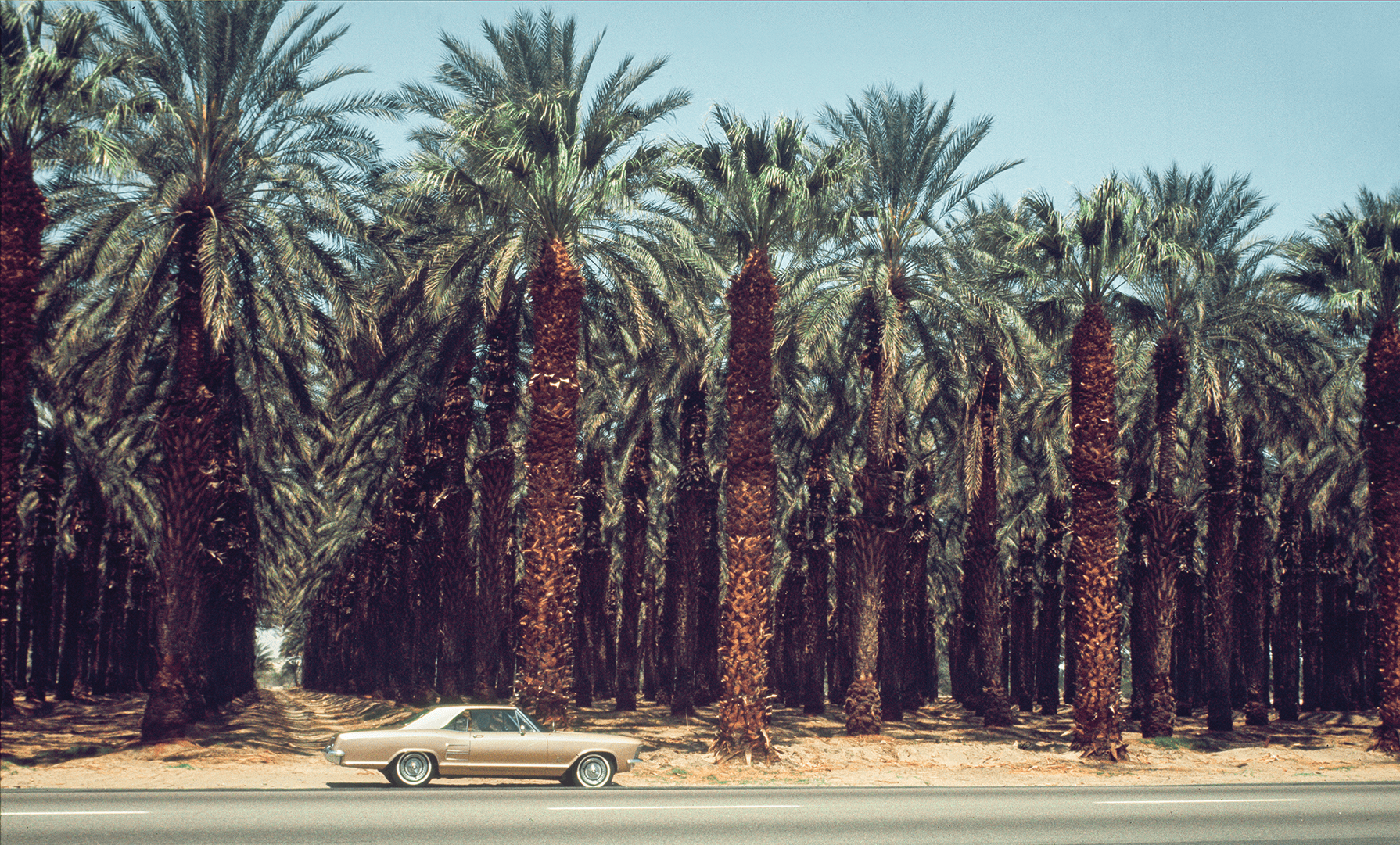
A stylish convertible as it parked down a growing Palm tree farm that is located in the heart of the Coachella Valley. In the American West residents love landscaping with the palm, it is their icon of oasis in the desert and the nostalgic promise of better shores.
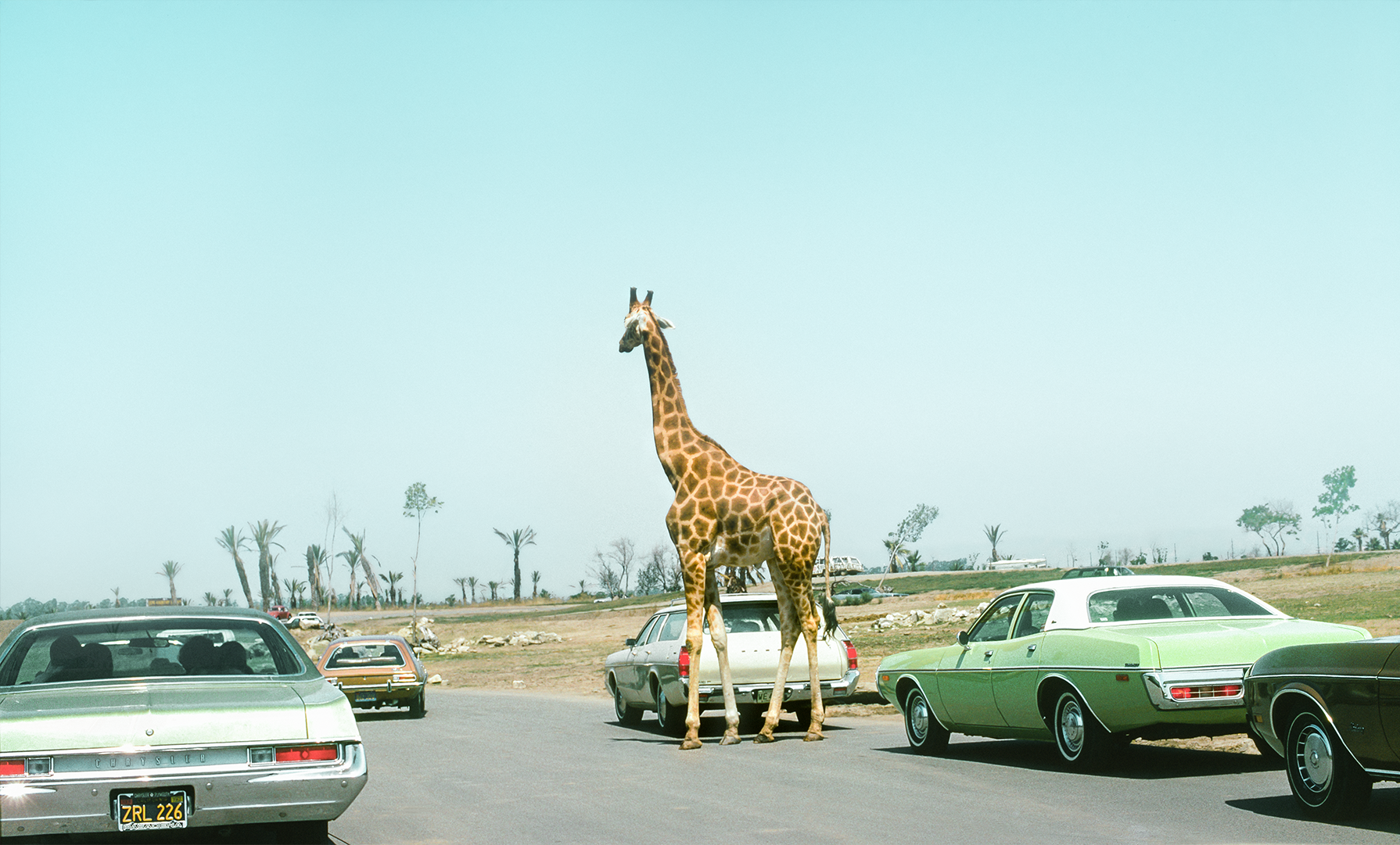
Before the 60s, if you wanted to see wild animals in their natural habitat, free from the confining cages of a local zoo, you had to travel to an exotic locale. That is, until a group of entrepreneurs had a grand idea; a drive-through zoo! Lion Country Safari proved that a family could have a great time sitting in the comfort of their car while viewing man eating-lions, graceful giraffes, and grumpy rhinos through the relative safety of an automobile windshield.

During the 1960’s and 1970’s, about 300 craft cooperatives were formed throughout the United States. The Co-operatives provided incentives to American Indian artists representing over several tribal nations for the preservation of their contemporary and traditional crafts & culture. Could this scene not been taken straight out of a Wes Anderson movie?
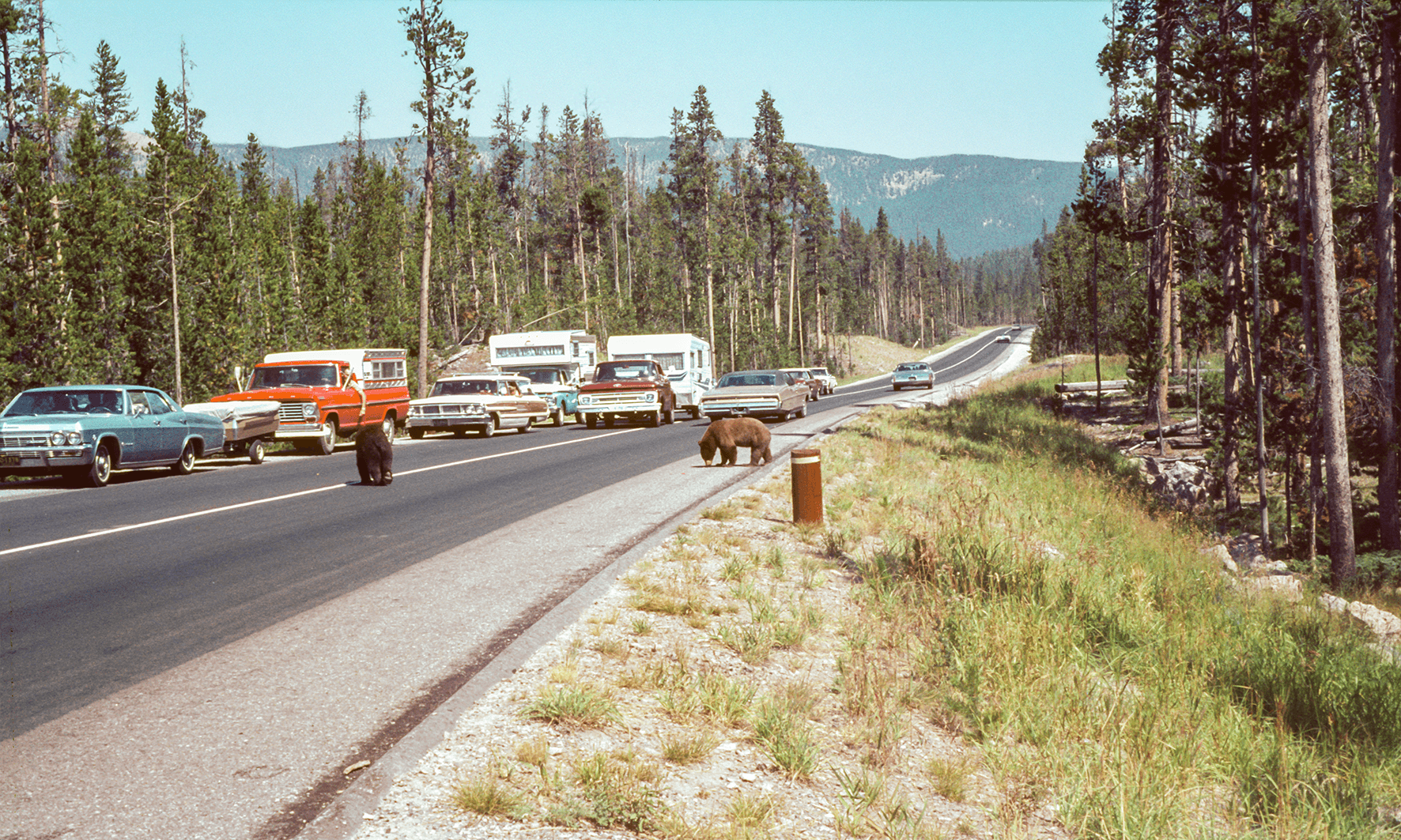
Panhandling bears lingered by the roadsides knowing people would stop and throw out food to them. Viewing grizzly bears and American black bears from roadways became as popular than geyser watching in Yellowstone National Park.
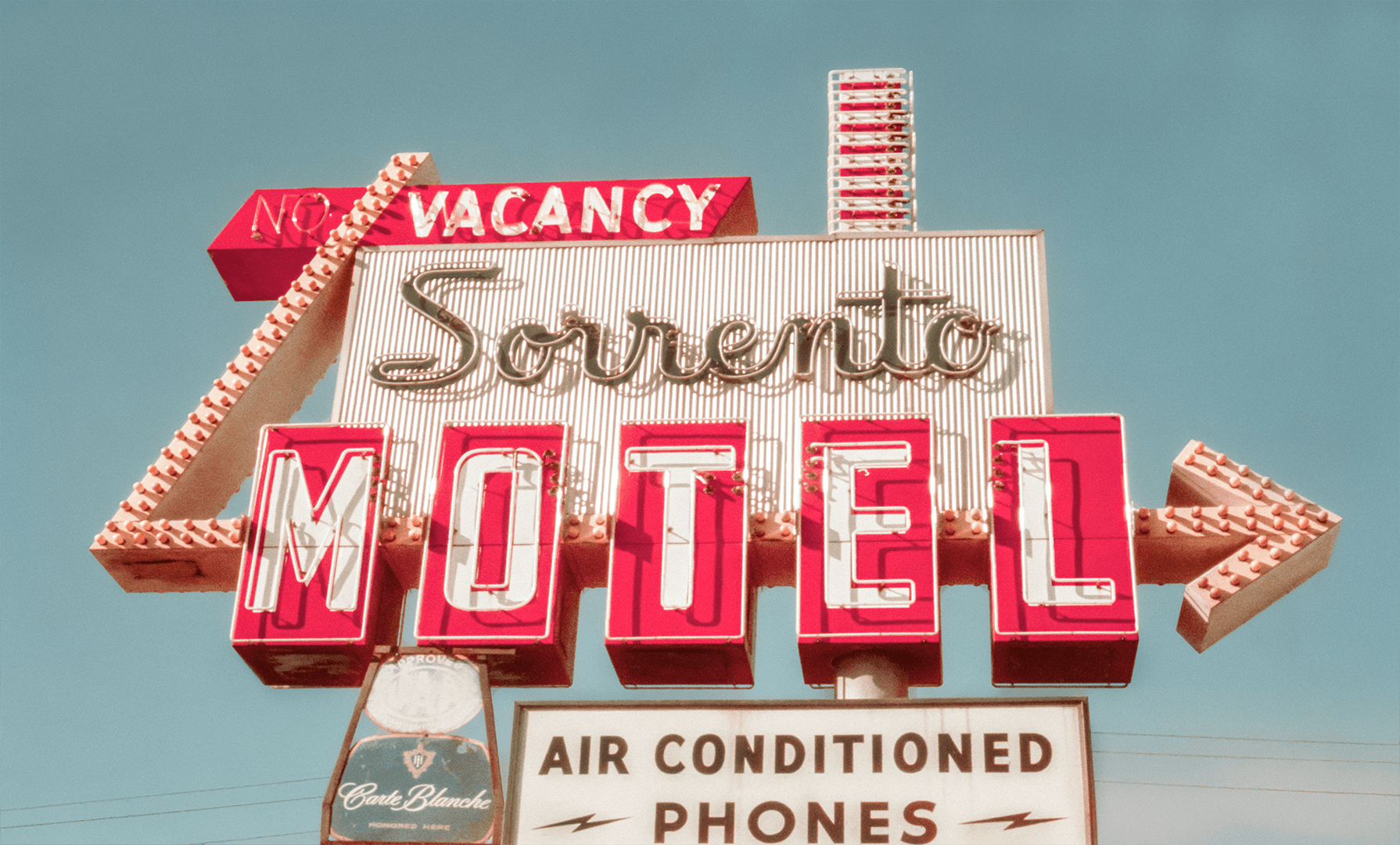
Motel signs...they don't make them like they used to. And according to this sign, direct-dial phones and air conditioned rooms are among the amenities that probably seemed a lot more impressive back then. Vintage motel signs, from east to west and everywhere in between. America’s love affair with the road.
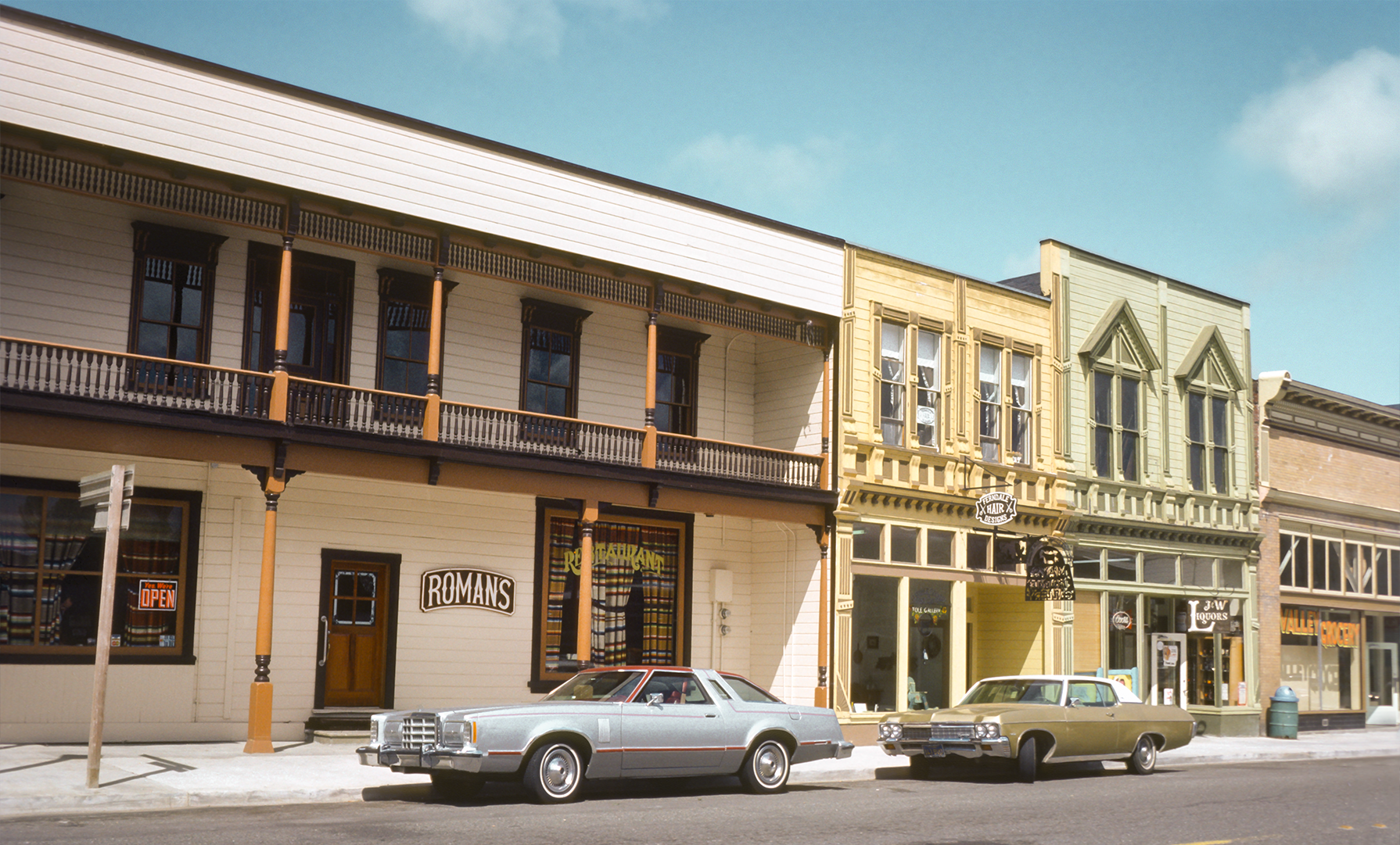
Situated near the intersection of Centerville Road and “The Wildcat”, the mountainous road to the Bear and Mattole River Valleys, Ferndale has been the location where film cameras roll to the call of “Action!”. When a Dr Pepper commercial was filmed here on Main Street in the late 1970s, many locals were hired to dance and sing, “I’m a Pepper. You’re a Pepper.” Even some of the town dogs were “Peppers.”
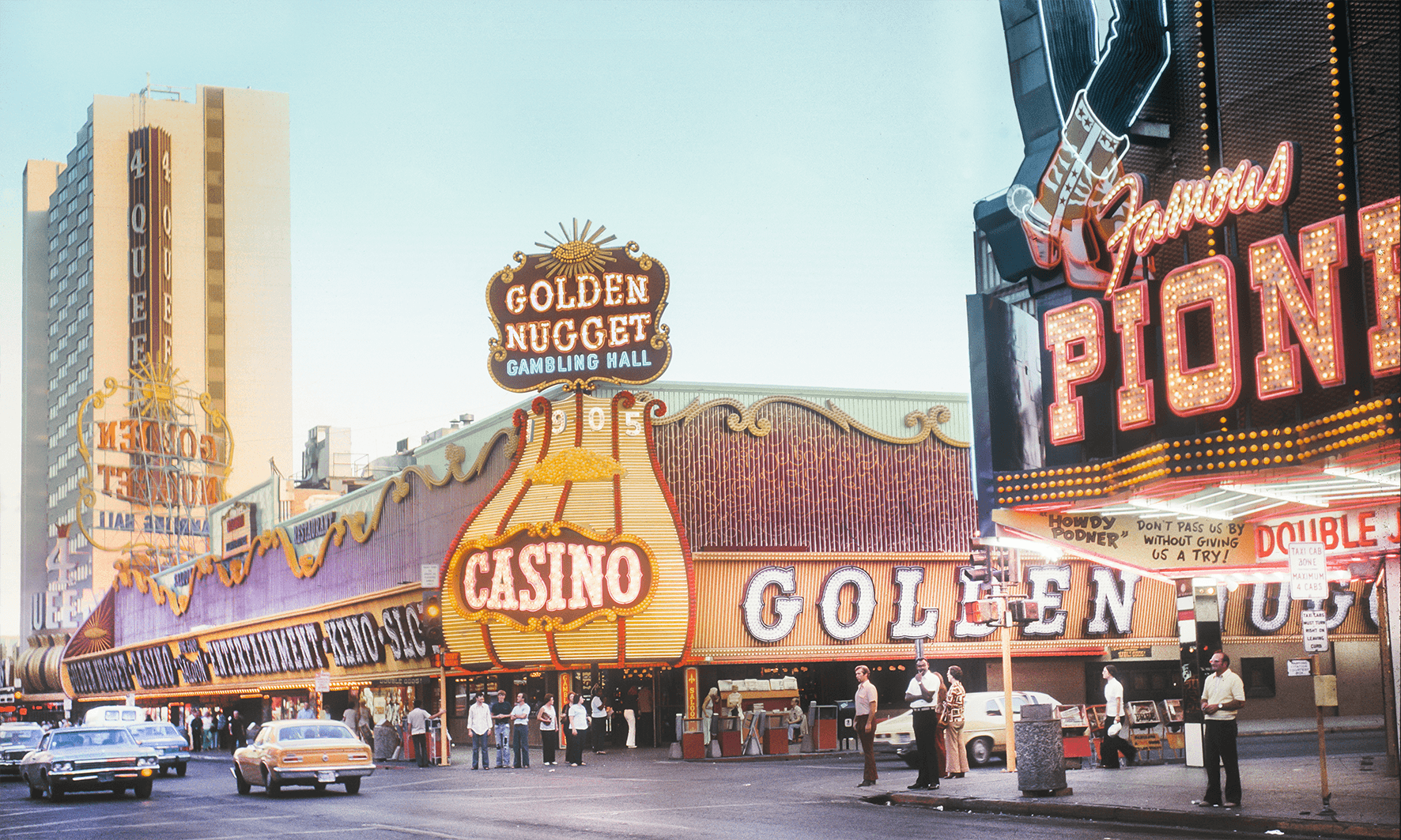
The 1970s became a defining decade for downtown Las Vegas. The Golden Nugget located at Fremont Street added its marquee styled facade and 'bull-nose' entrance. In the James Bond film Diamonds Are Forever the casino can be continually seen in the police chase scene.
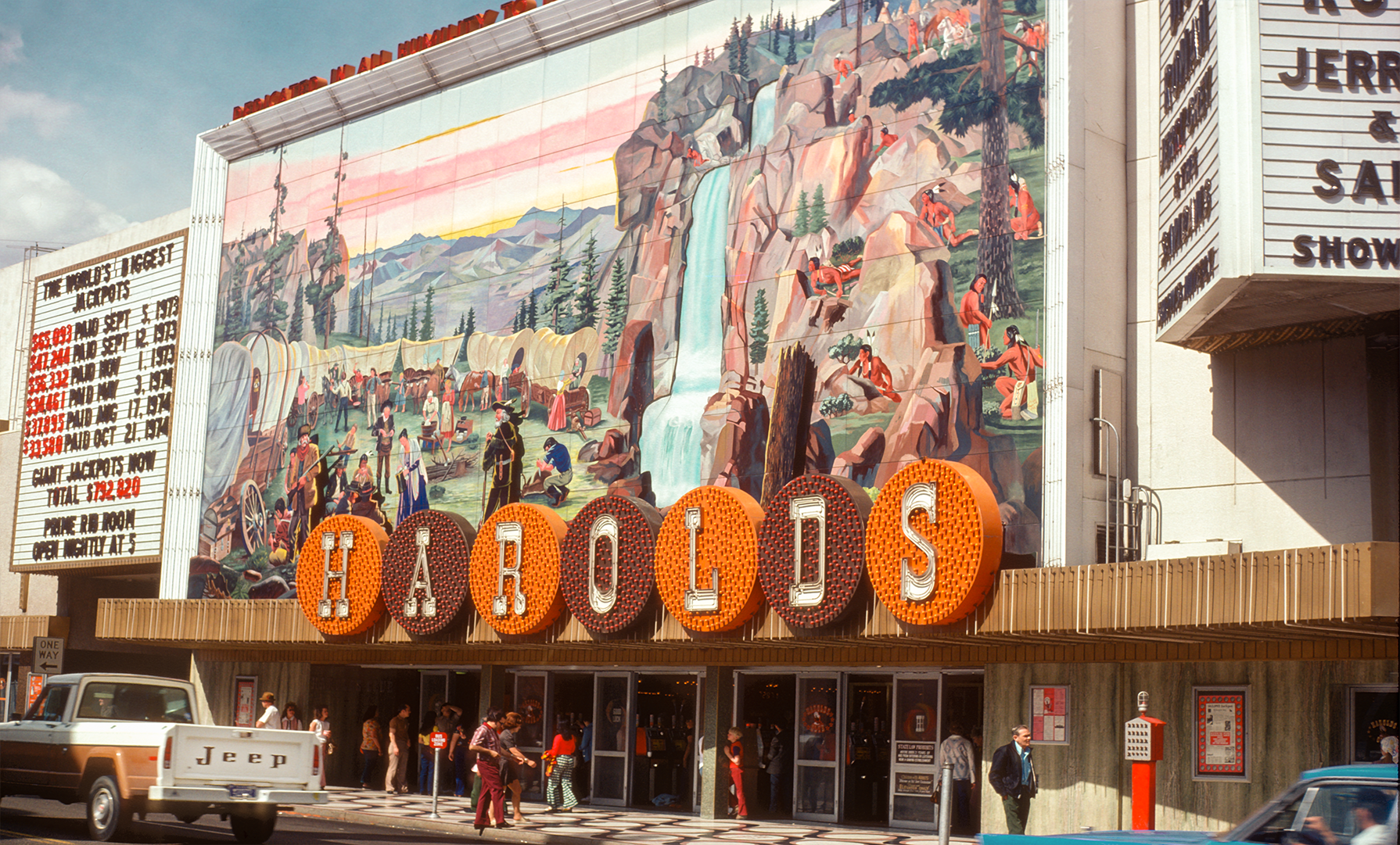
Old West pioneer settlers resting on their journey, curious Indians peering from cover. An animated waterfall. The title above read..."Dedicated in all Humility to Those who Blazed the trail." The Harolds Club facade was sculptured by Sargent Claude Johnson.
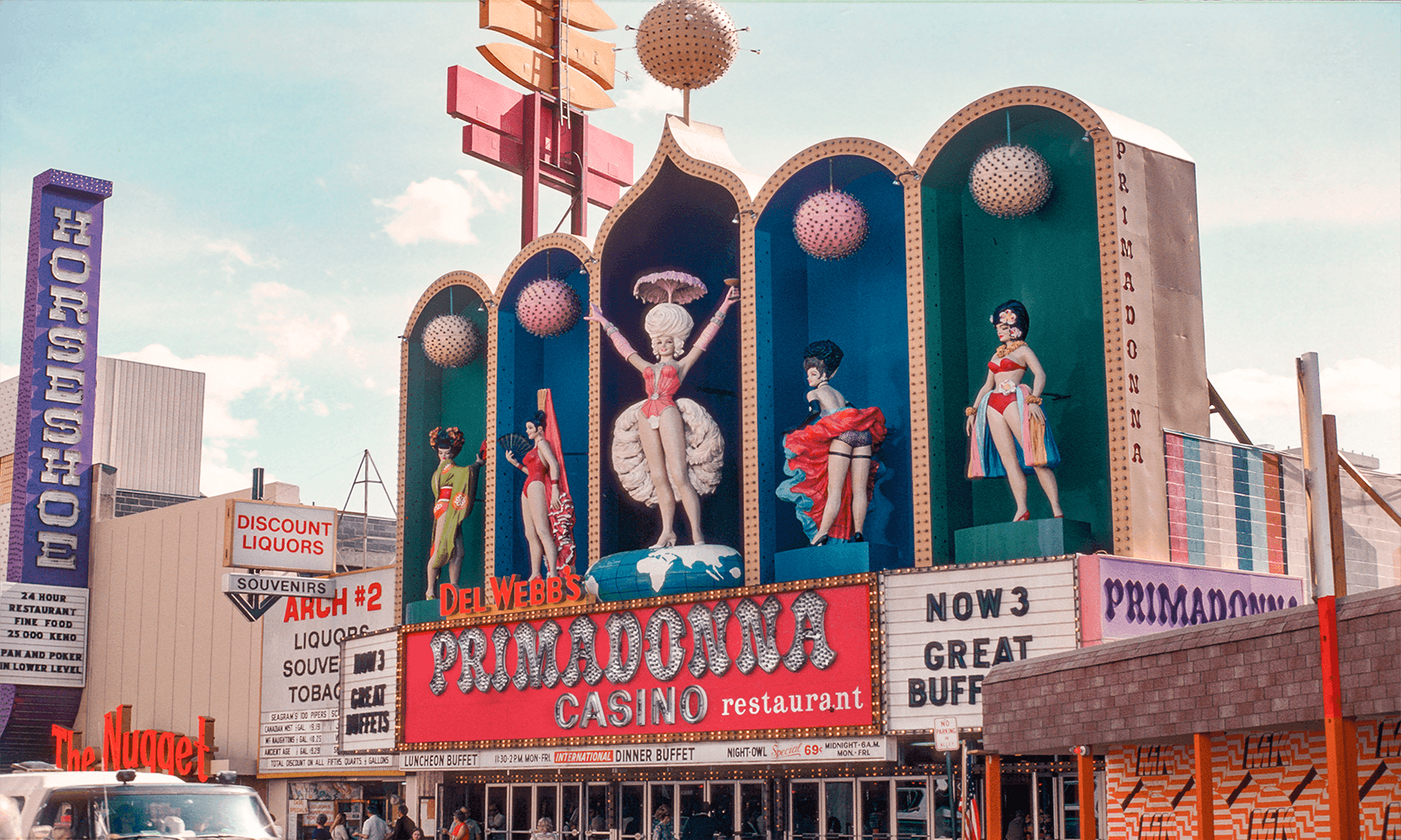
In the heyday of the casino culture, the showgirl was the living symbol of Reno’s elegance. They were put up on a pedestal as an iconic thing and one casino even had a showgirl theme. The Primadonna became a real trendsetter with its bold colors, flamboyant decorations and the famous exterior with the five showgirl statues on the facade.
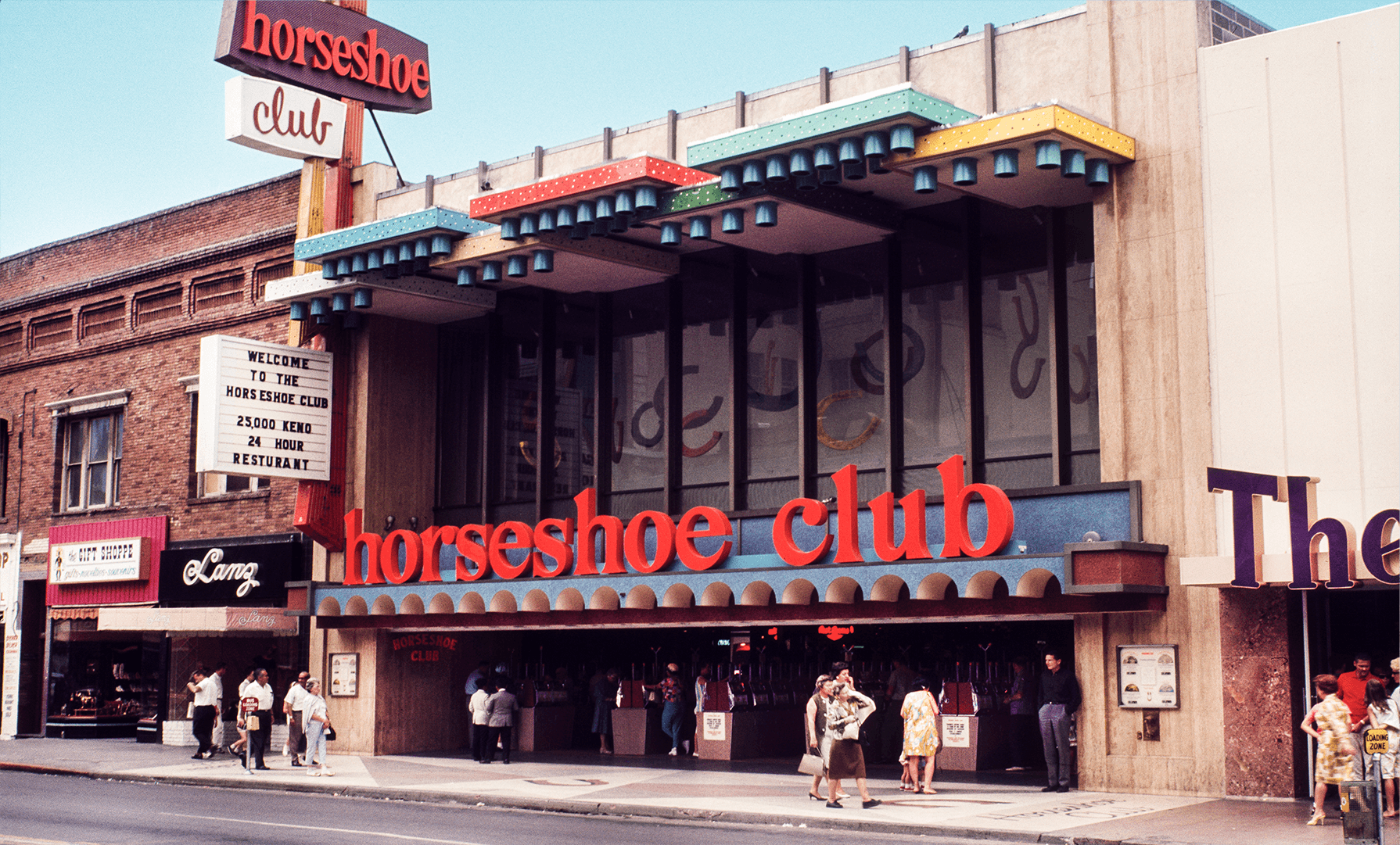
Avant-garde defined Casino signage that grooves in flashy red. It feels like the swinging sixties and I wonder if the front face design of the place is Art Deco influenced. The Horsehoe Club on Virginia Street opened in 1956 promising “Fun, Food and Fortune”. Reno known as "The Biggest Little City in the World", became world famous for its casinos.
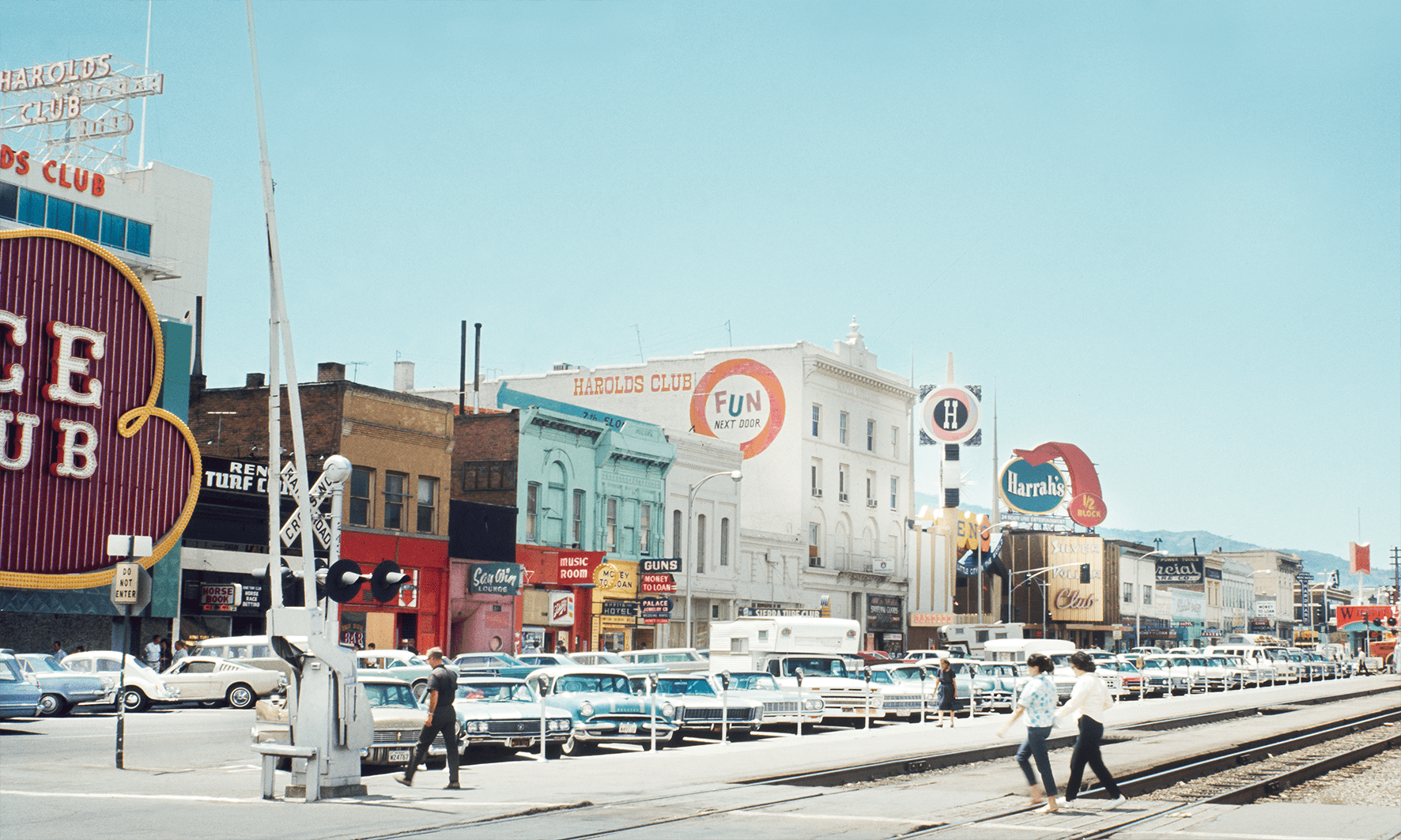
“The Biggest Little City in the World" founded during California's gold rush and first to reach prominence as a gaming center. Unfortunately it became a victim of popular culture during the mid 1960s. Acts like The Rat Pack and Elvis Presley began calling Las Vegas their home. Now, not only could people stop in at Sin City to partake in otherwise questionable behavior while receiving their gambling fix, but also being personally serenaded by Frank Sinatra in the process. Reno didn’t stand a chance.
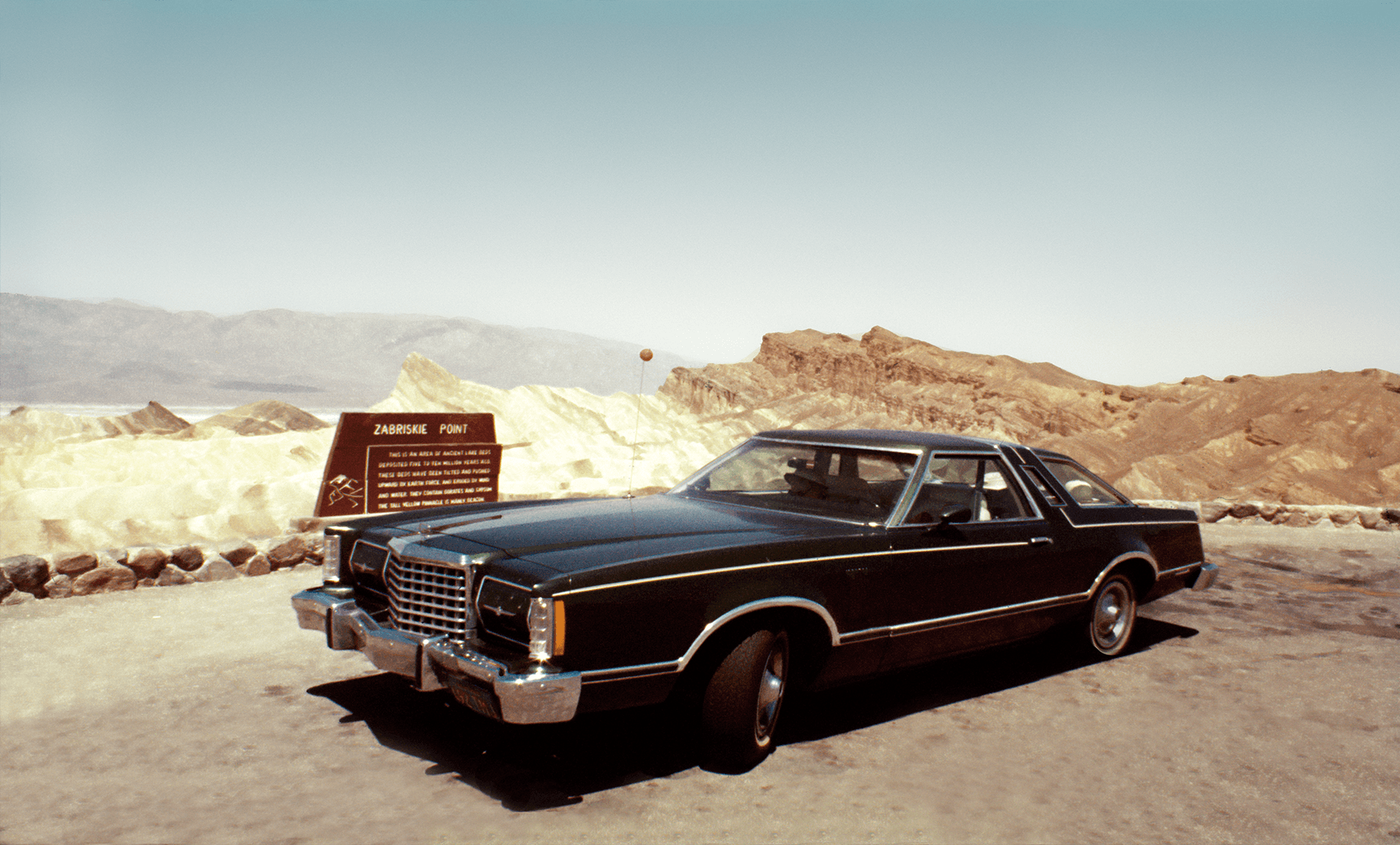
Zabriskie Point is the lowest point in the North American continent, a part of Death Valley. In the past it was possible to drive right to the edge of the overlook of a huge area of yellow-brown-black badlands, with the white salt flats in the main valley beyond. An 1970 American drama film directed by Michelangelo Antonioni was shot here and to some extent achieved cult status.
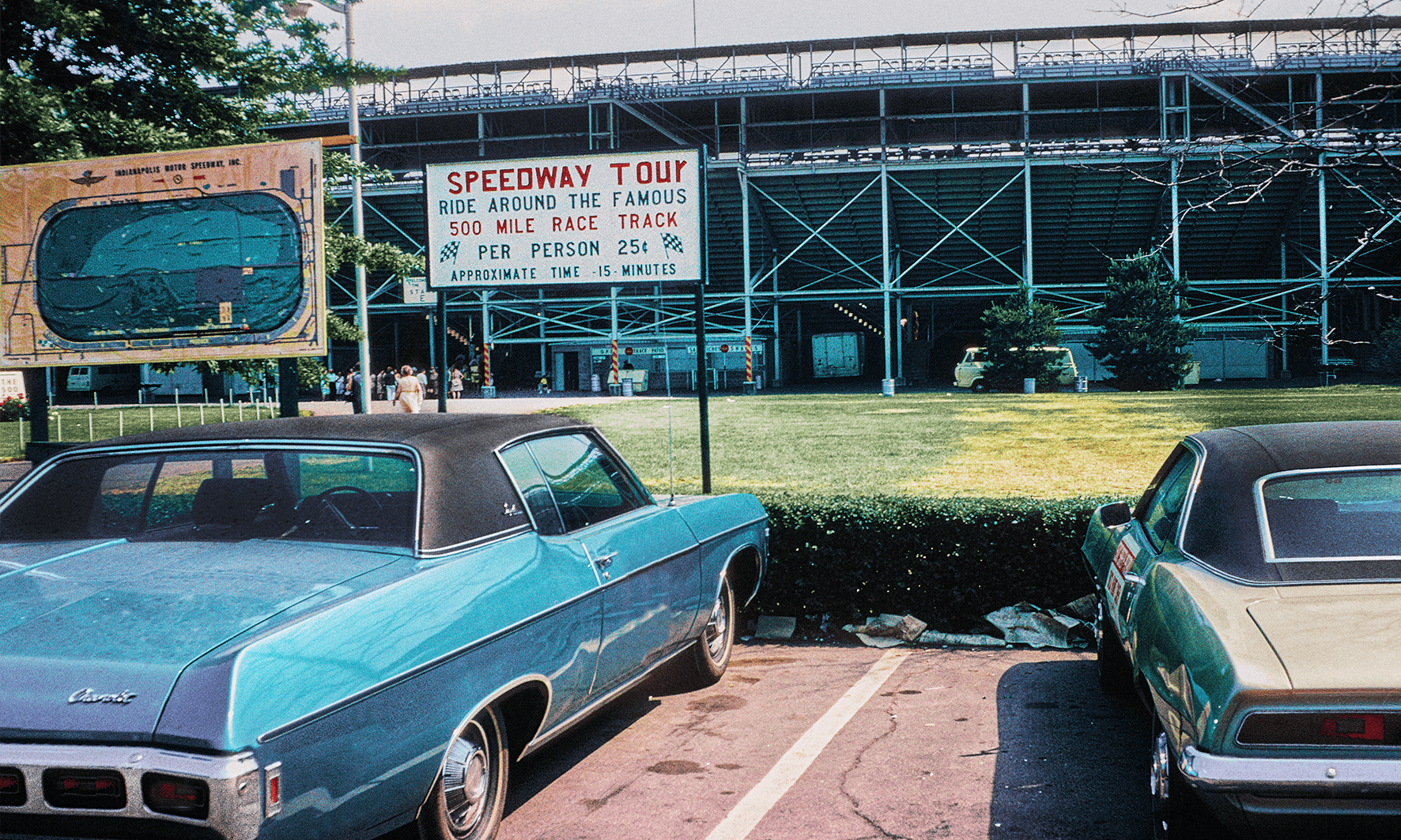
Built on 328 acres of farmland five miles northwest of Indianapolis, Indiana, the speedway was started by local businessmen as a testing facility for Indiana’s growing automobile industry. The idea was that occasional races at the track would pit cars from different manufacturers against each other. After seeing what these cars could do, spectators would presumably head down to the showroom of their choice to get a closer look.

Visit this bank without getting out of your car. Drive-through teller stations, once promoted as a convenience for the after-work crowd wanting to keep Bob Dylan songs playing while depositing their paychecks. Drive-throughs have generally replaced drive-ins in popular culture, and are now found in the vast majority of modern American fast-food chains. It was 1975 when the first McDonald's drive-through was created in the U.S.

Stylish cars driving around the valley of the famous Camelback Mountain, the palm trees rising on either side like tall and thin, pillars of towering opulence, it feels like the icons of a bygone age.

An old-fashioned community parade, spectators line the streets keeping them enthralled for hours. Sparkle and shine, a teenage girls marching band performs developed and harmonized arrangements of music, a sense of nostalgia and pride here from the 70’s.

A motel nestled in the picturesque village of June Lake. Colorful granite peaks rise above the lakes and village where local waterfalls are reminiscent of Yosemite. Glacial moraines frame the Loop. The crystal blue waters of June Lake and the road overlooking it have been popularized in numerous car commercials. In Fall, the turning and flaming colors of the thick aspen groves feels like we’re in the Twin Peaks universe.

High in the Rocky Mountains and once a booming gold mining centre, Virginia City during spring. It is the wild west again, tourist style 1975. Be careful staying at the Fairweather Inn. Rumor has it that it is home to some ghostly children, witnesses described footsteps, whispers, the rustling of old-fashioned dresses, and doors that opened and closed on their own. The film The Missouri Breaks was partly filmed in Virginia City.
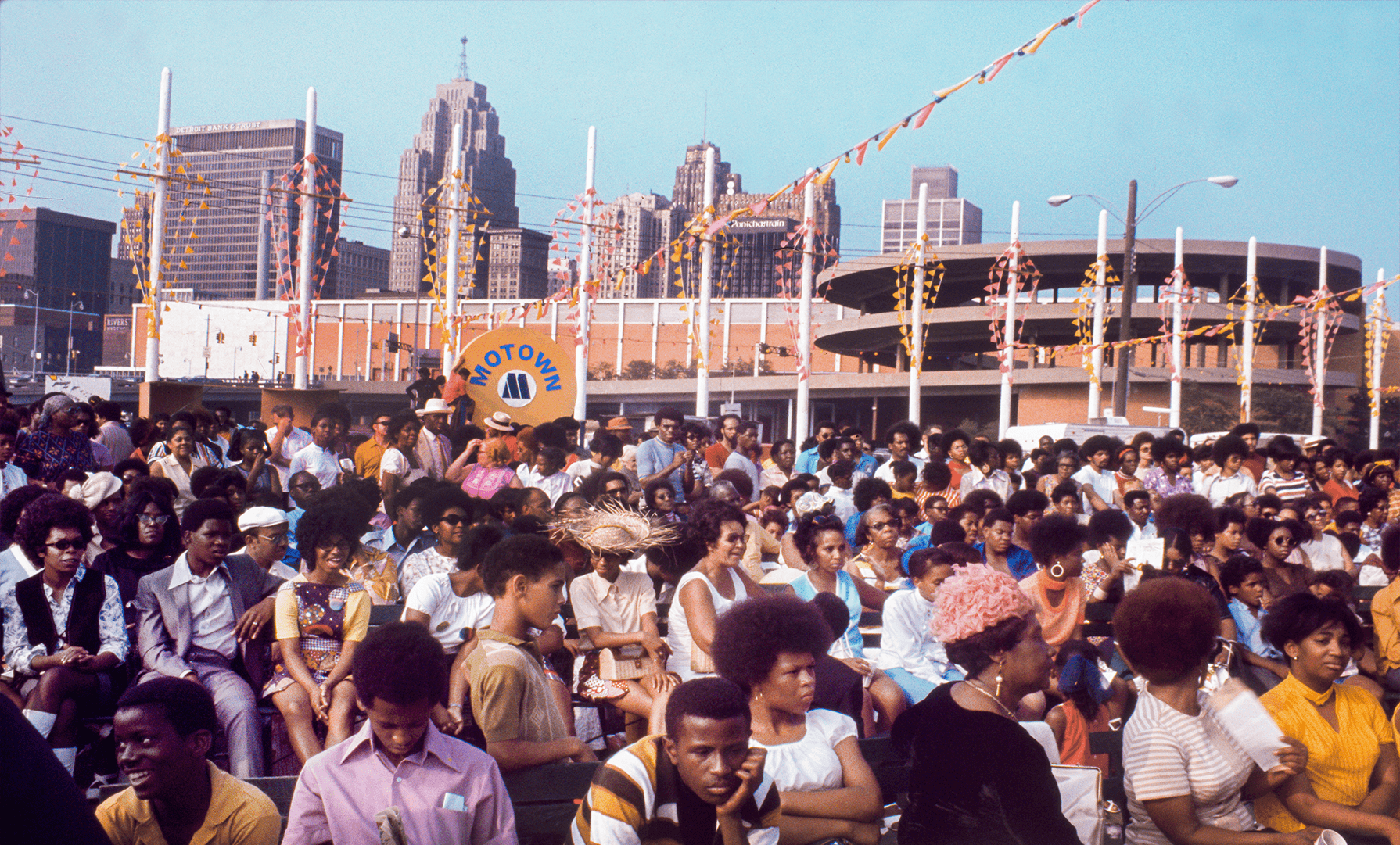
A crowd dressed up for a Motown concert at Cobo Hall. Detroit took on the nickname "Motor City" recognized as the heart of the American automotive industry. In tribute to what Motown's founder Gordy felt was the down-home quality of warm, soulful people he grew up around, used “town” in place of “city”, which gave him the contraction “Motor Town” and the perfect name for his company and the label Motown.
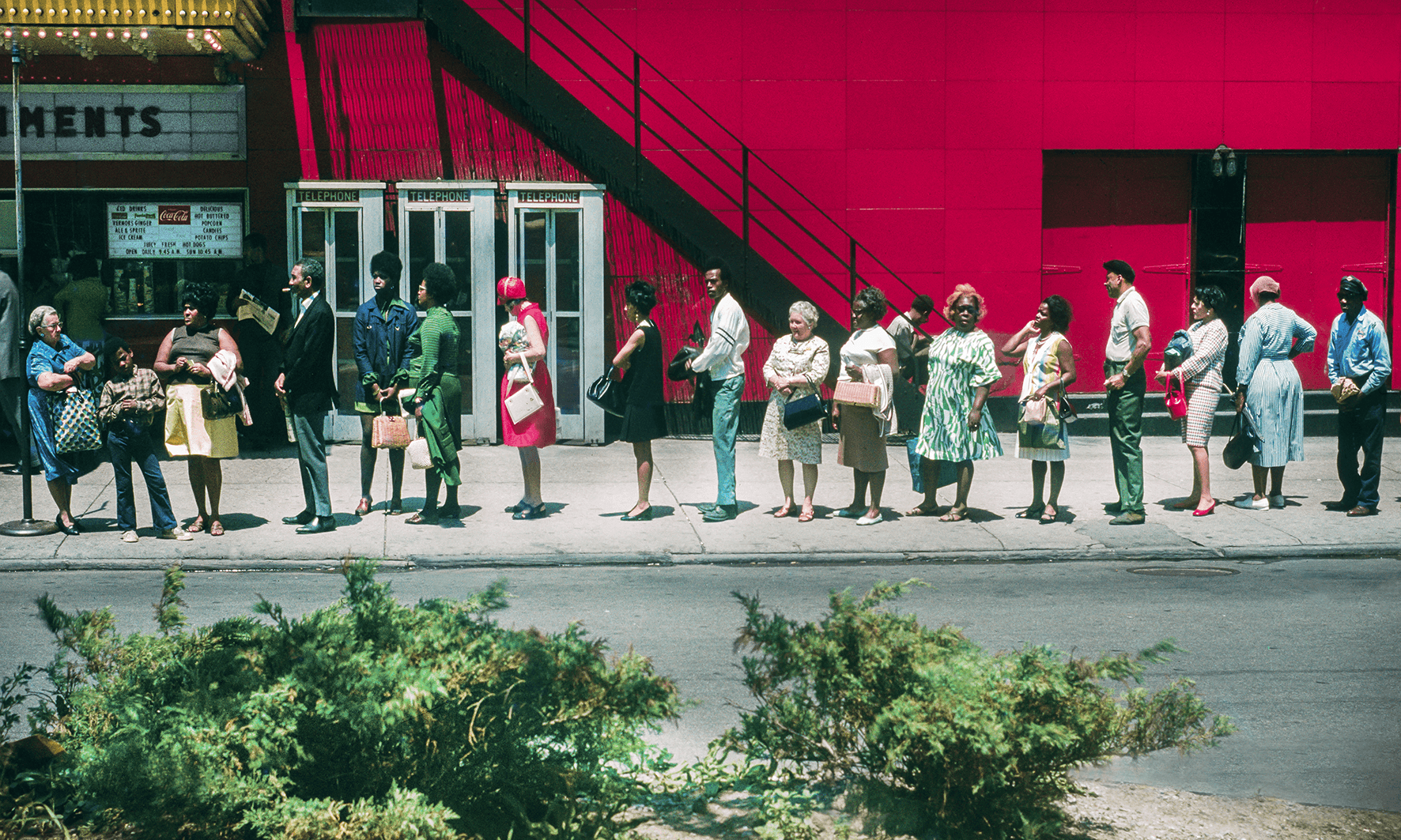
It's the bus queue that is often cited as an example of the demise of civilised queuing. In some places it's every man, woman and child for themselves when the bus draws up. Clear evidence the orderly queue seems to have been an established social form in Detroit. You would think a product of more urbanised, industrial societies which brought masses of people together.

Young man, there’s a place you can go. I said, young man, when you’re short on your dough. You can stay there, and I’m sure you will find. Many ways to have a good time. It’s fun to stay at the Y-M-C-A. It’s fun to stay at the Y-M-C-A.”
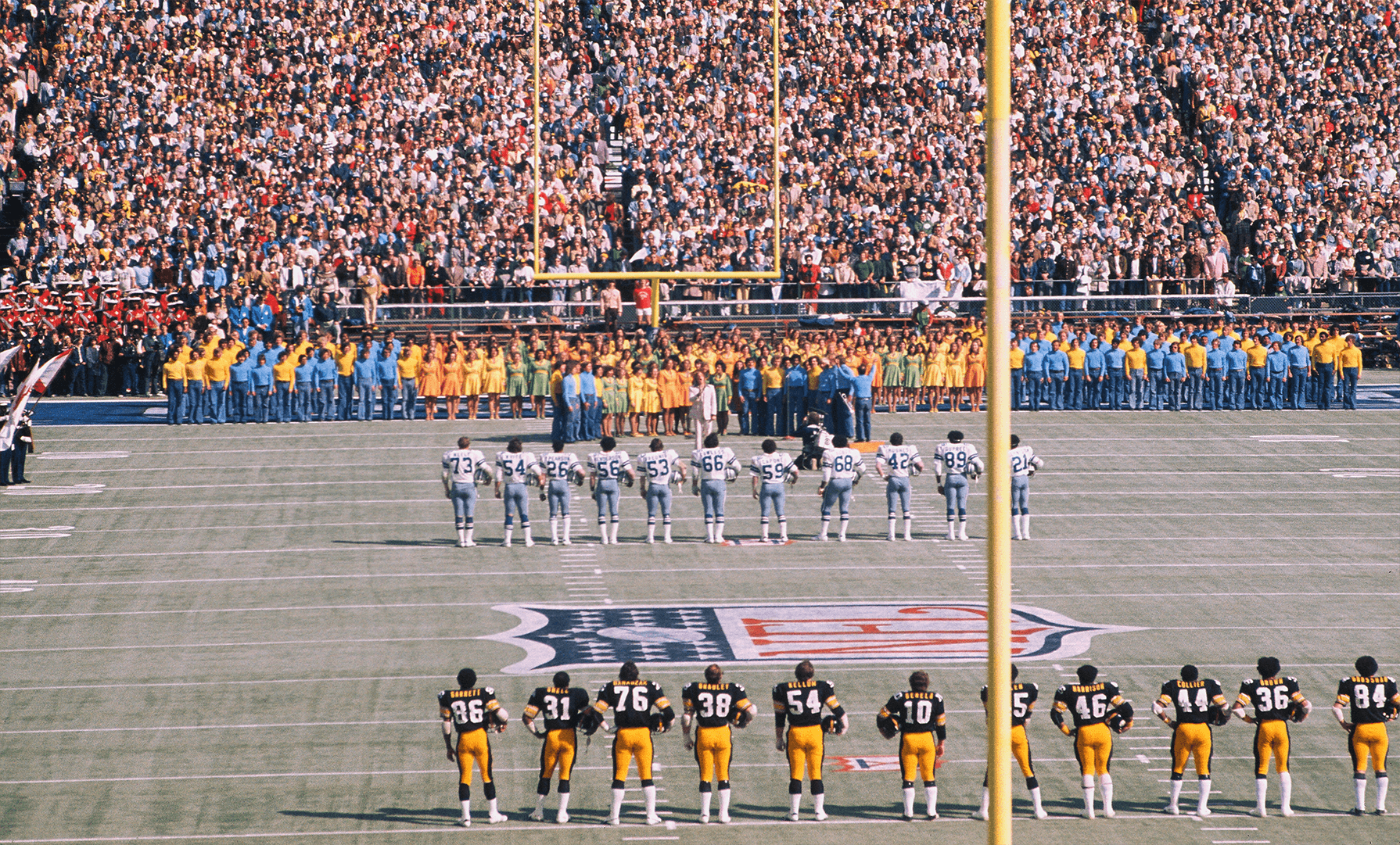
The Steelers and Cowboys met in Superbowl X. When those fans close their eyes today and picture the ideal football team, they cannot help but picture the mid-'70s Steelers, clad in all black, galloping in NFL Films slo-mo, beating opponents with brutal determination. The Steelers did win and it was remembered for being the most exciting of the first 10 Super Bowl games in history.

Lower, wider, and longer is how Detroit made cars in the '60s, and this 1966 Ford Galaxie 500 coupe is arguably the best way to show that off. The people at Ford placed the headlights and taillights as far in the corners of the body as possible. That way everything looked stretched to the max. This allowed for some seriously large chrome elements. It's hard not to love the mid-60s Galaxies.
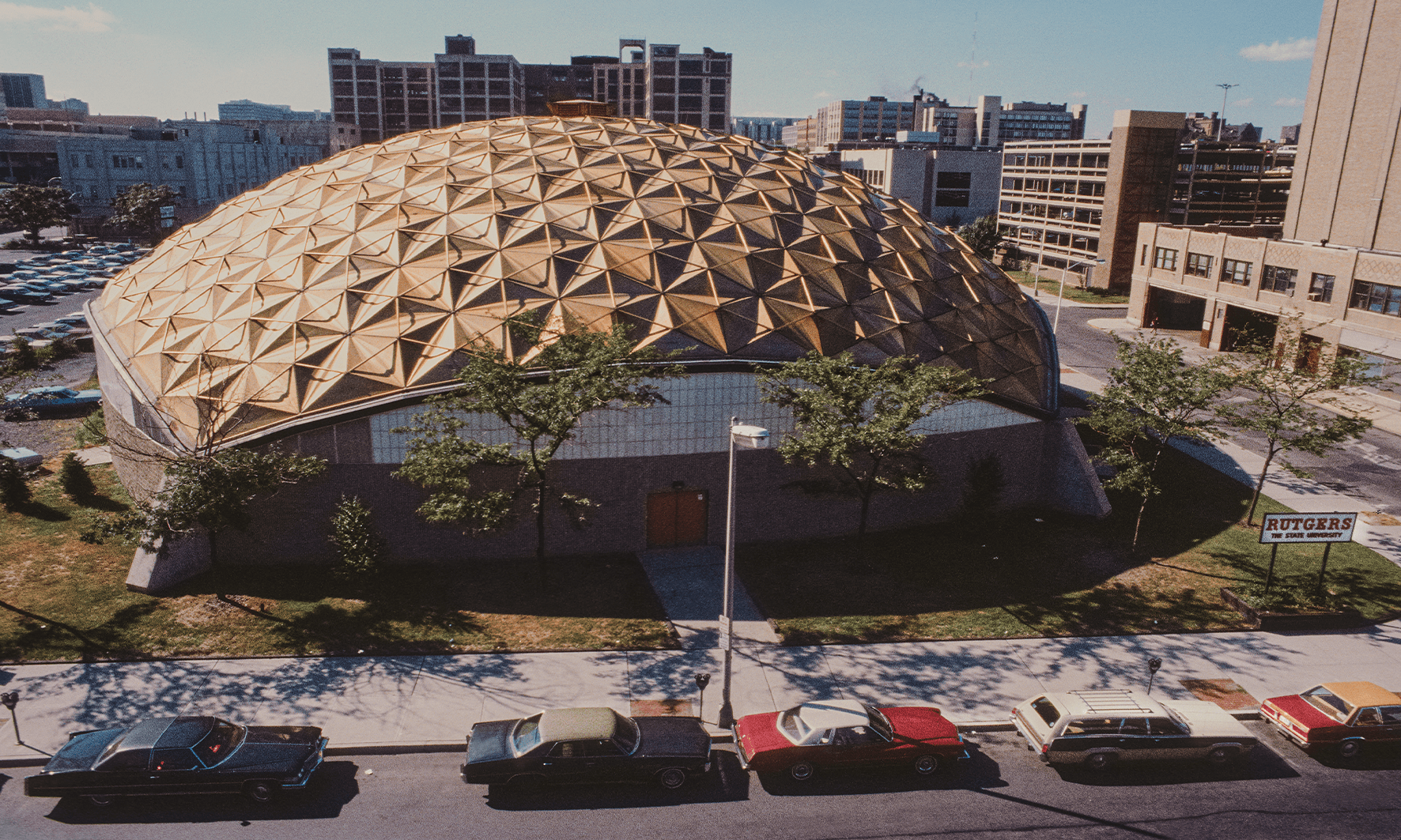
When we look back on the artistic accomplishments of the mid 20th century, many times we neglect the significance of the geodesic dome. This gymnasium is a Buckminster Fuller-Inspired Gold Dome and opened officially in 1977 in Newark. Not only was this design original, but it served as a symbol of the modern impulse of glorifying technology and science.

New York's streets are constantly changing to reflect the dreams of each new era, and perhaps none has evolved more dramatically than 42nd Street. During its heyday in the 1960s and ‘70s, the block of 42nd Street between Seventh and Eighth Avenues was know as "the Deuce". Theaters may fill Times Square today, but they're a far cry from the movie palaces that once populated in this neighborhood.

It was a local entrepreneur Clarke Sanford that had this art-deco style theater built. Sanford brought 20th-century invention, the movies, to Margaretville in the Catskills. The theater was named after opera star Amelita Galli-Curci, whose Sul Monte estate was in nearby Highmount, if she sang at opening night in 1922, which she did, closing with "Home! Sweet Home!".
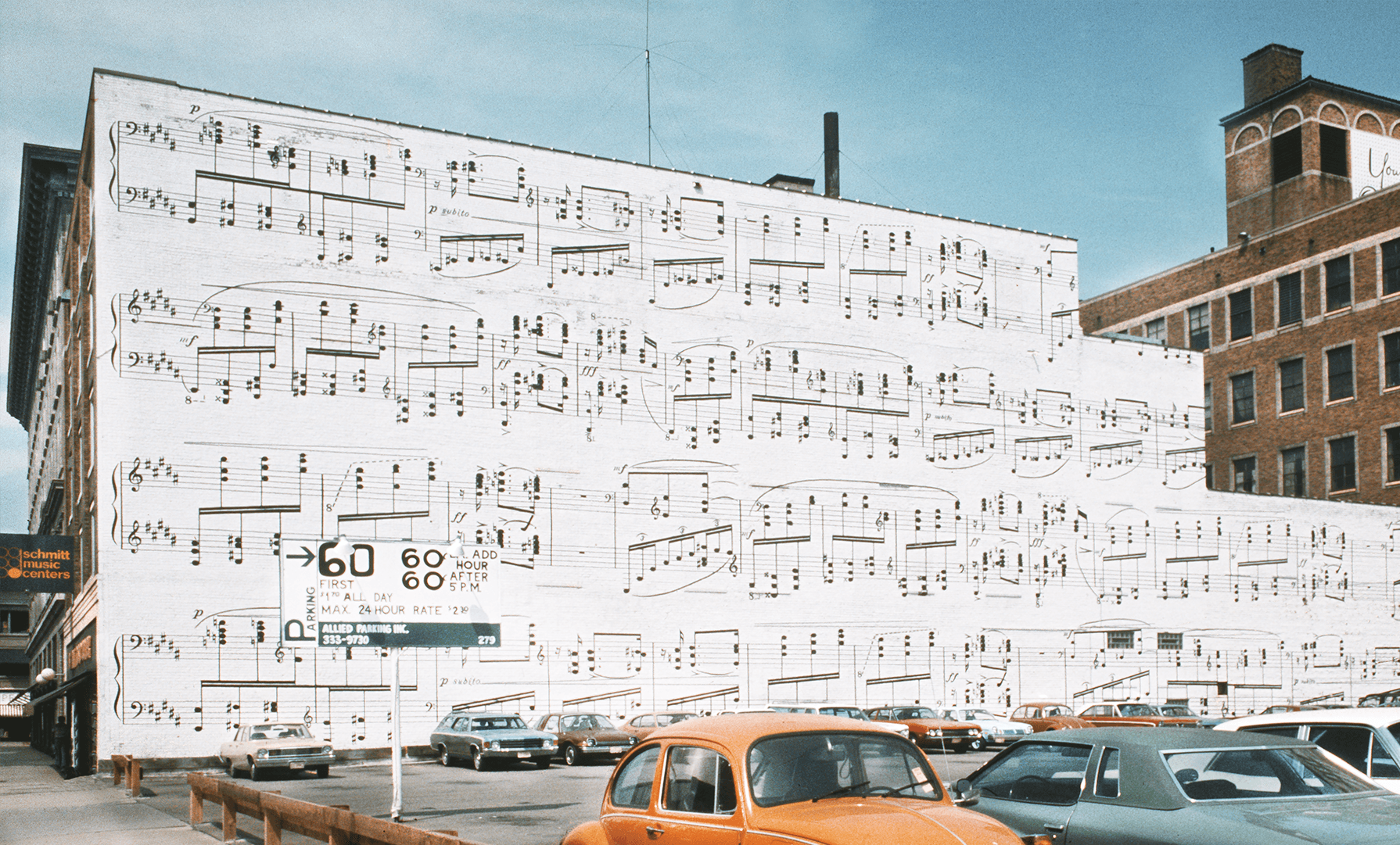
Now that's a wall of sound! Schmitt music centers chose notes from a musical score that could be painted as a mural over the enormous facade. After completion Minnesota-born artist known as Prince famously posed in front of this mural in 1977. The portrait of the young Prince was taken at the age of 19 years old and it became his first professional photo shoot, one of his most iconic images.
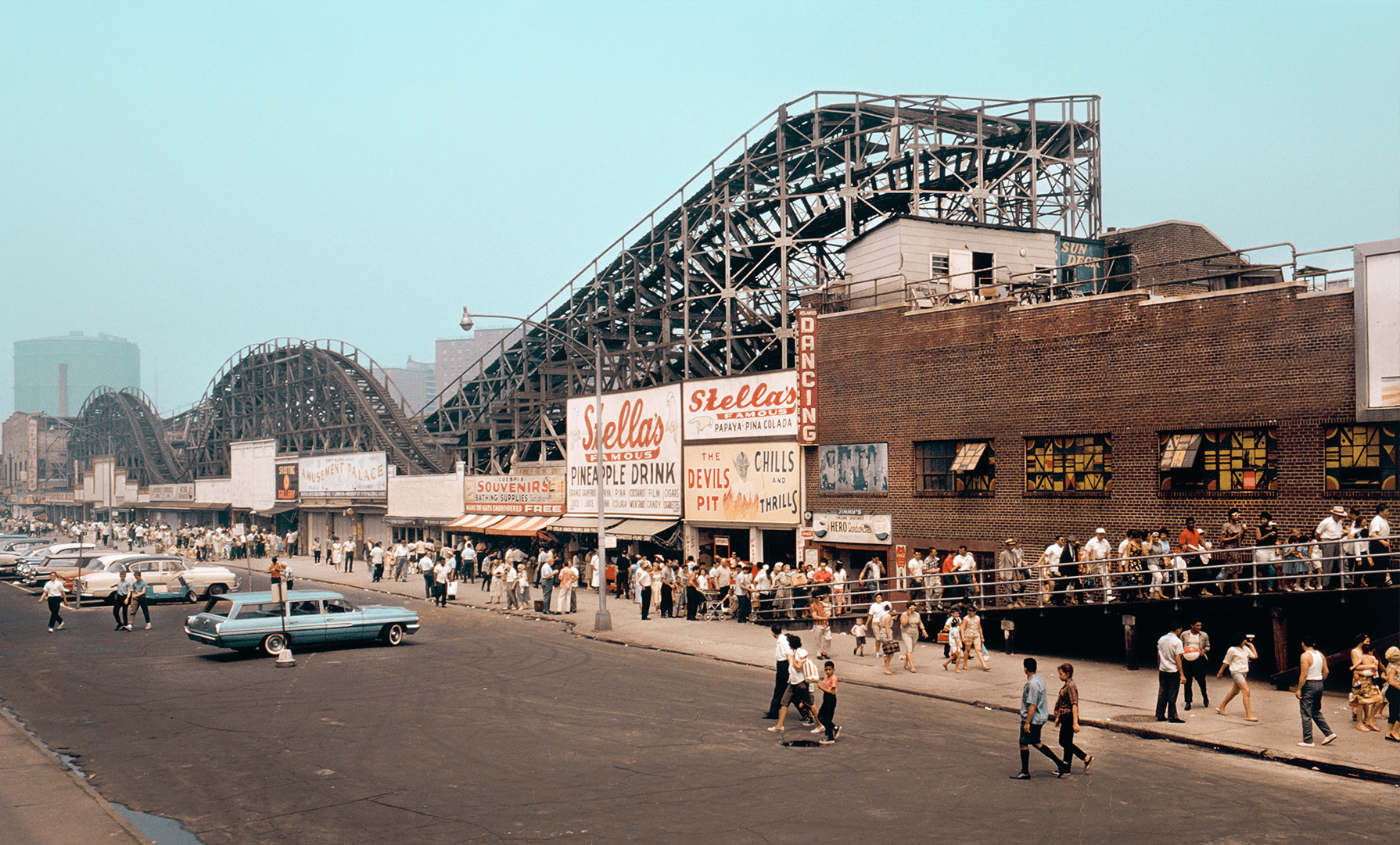
Located at Coney Island this wooden roller coaster, the Thunderbolt, was featured in Woody Allen's 1977 film Annie Hall. One of the coaster’s most famous aspects had nothing to with the ride it gave, but with the house that sat under the first and third turns. The family that lived in the house used to find teeth, wigs, glasses, guns in the yard. Everything they found in the yard…according to the story, nobody came back for them, though.
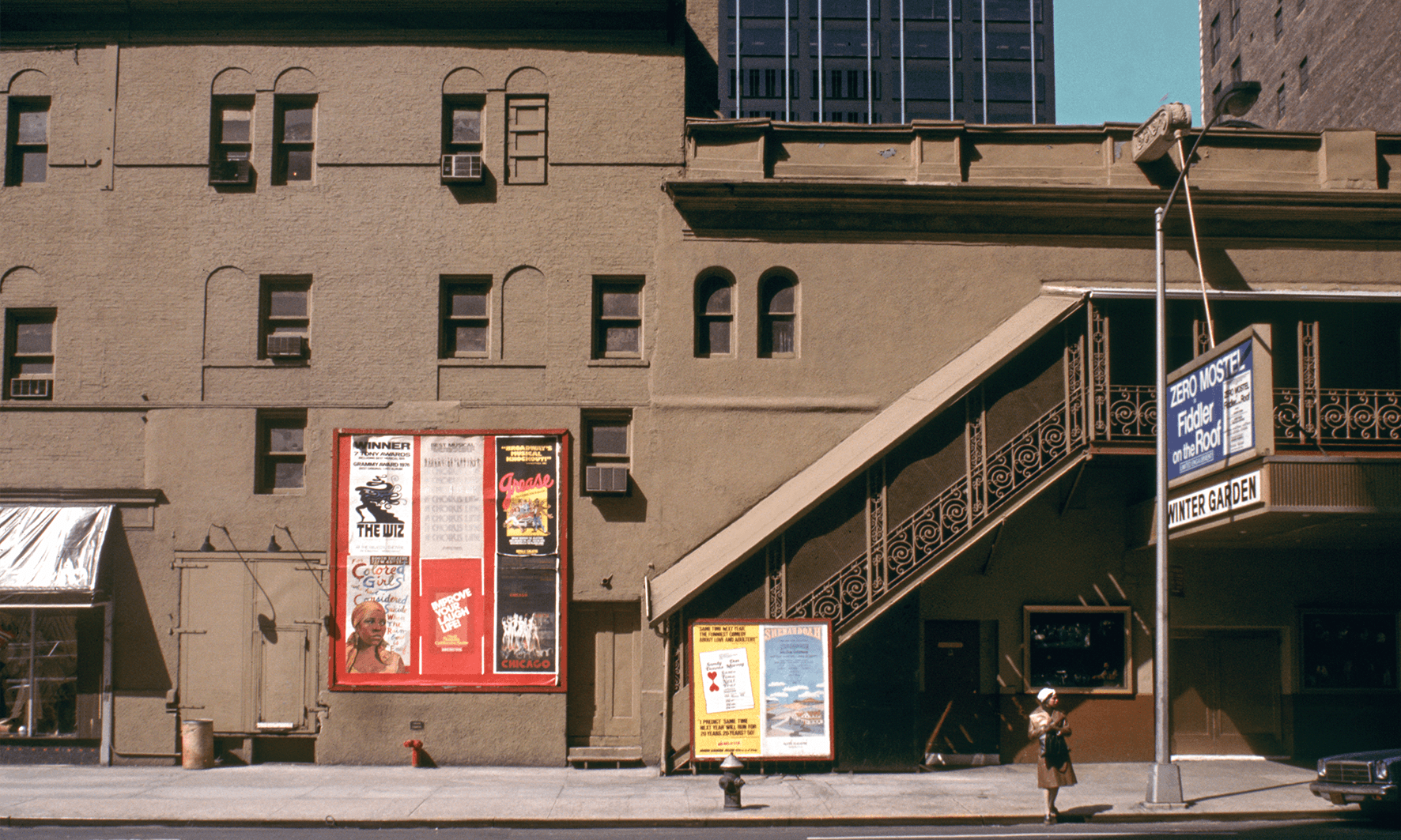
Passing the backside of Wintergarden, the theatre on Broadway carries classic and contemporary musical posters. The 1970s proved to be a great time for change and growth on Broadway with movie musicals that saw a rise following the success of Grease, both on stage and off. Fiddler on the Roof held the record for the longest-running Broadway musical for almost 10 years until Grease surpassed its run.

The Miami-Ft. Lauderdale area is known for many things. Sparkling beaches. Gorgeous weather. Nude sunbathers. Also, scores of beautiful foreign vehicles, daily-driven luxe and brightly-colored exotics. With all the plush droptops and scissor-doored goodness you’ll see cruising down the strip in South Beach these days, it’s easy to lose that enduring appeal of American Metal.
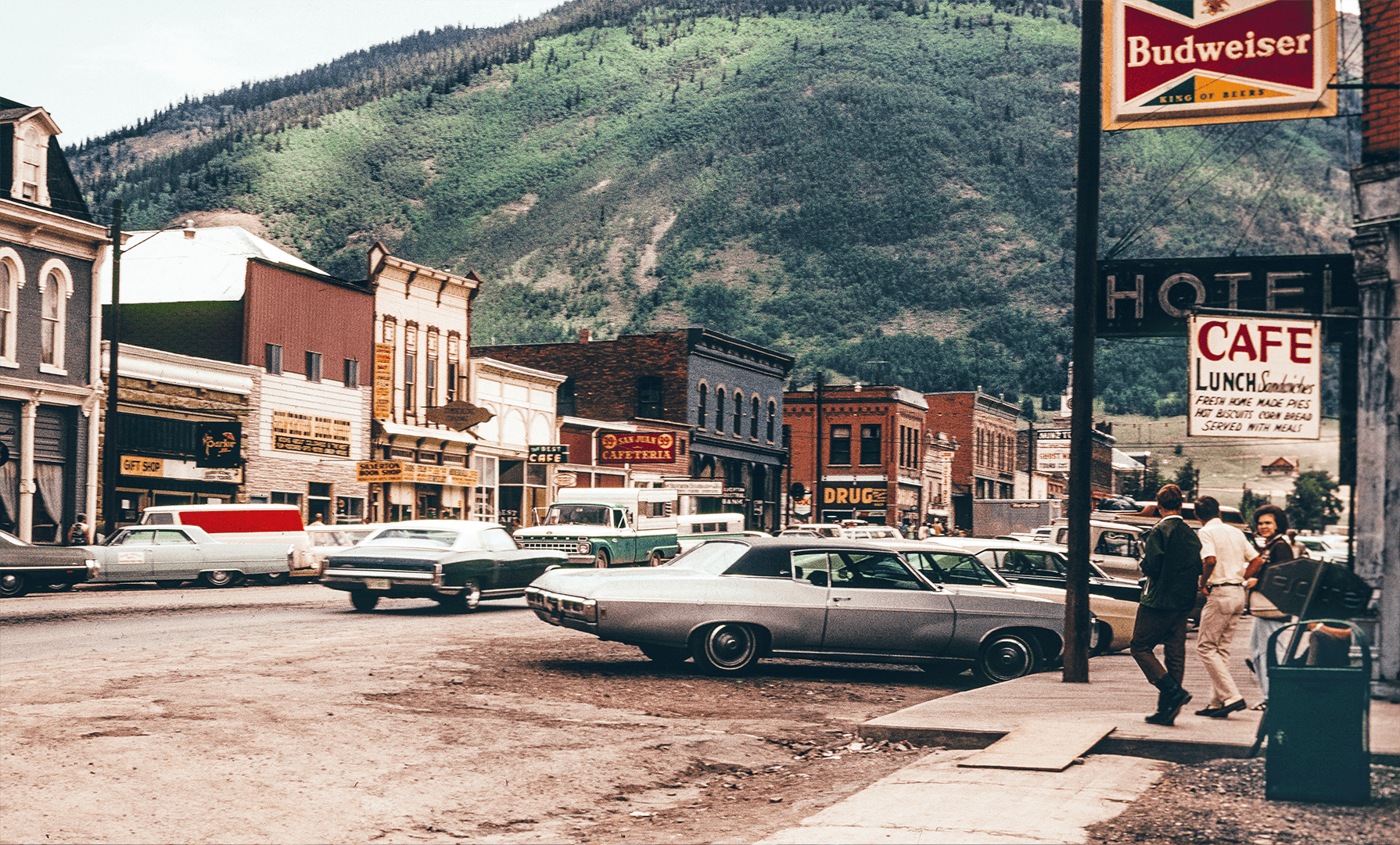
We tuck inside the Rocky Mountains, end of day and time for a beer. Budweiser, king of the beers apparently served everywhere. This quaint little town known as Silverton has roots in mining, half of Colorado's gold production in the 1970s came from the Sunnyside mine situated northeast of Silverton. The tiny settlement is an incorporated municipality with roughly over 530 residents.
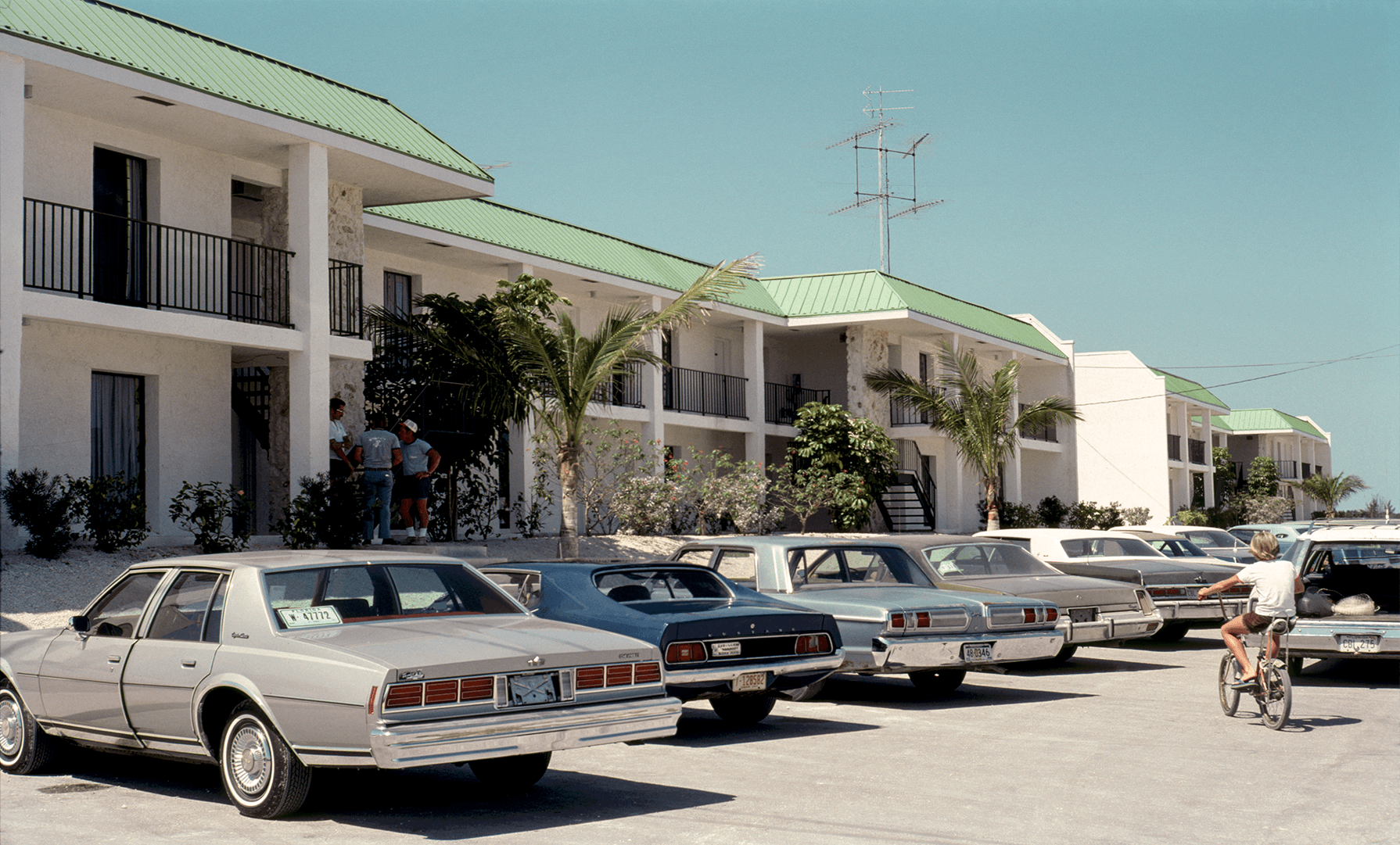
Apart from the beautiful foreign vehicles, this picture draws us into the kid on the bike. A type of stylized children's bicycle designed with the banana seat, as it came to be known. They were first produced in 1963 and together with the high-rise handlebars it gets the look of a "chopper" motorcycle. It was an instant hit among teenagers back then.
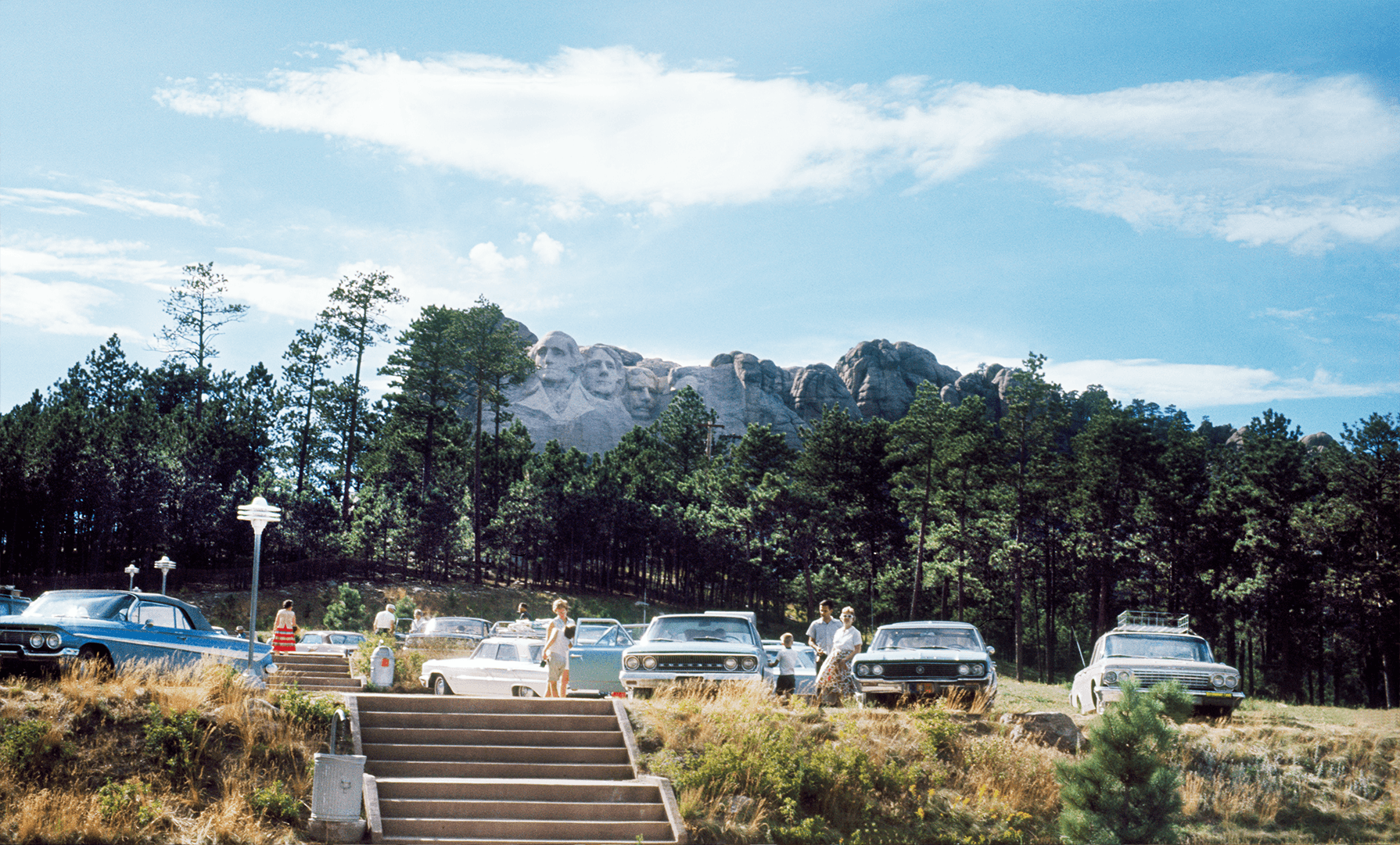
Four gigantic faces carved into a mountain hillside. It took 14 years to carve four sculptures of famous American presidents into the granite face of the mountain. George Washington, Abraham Lincoln, Thomas Jefferson and Theodore Roosevelt. Mount Rushmore became an iconic symbol of the United States while it appeared in works of fiction, as well as being discussed or depicted in other popular works.

Against the backdrop of two mountain ranges, the Grand Tetons and Gros Ventres, the Jackson hole valley here pictured during the mid seventies. A majestic escape that brings to mind the nostalgia of Western movies coupled with the untamed beauty of the wilderness. Even more current is "Django Unchained”, Quentin Tarantino's spaghetti western shows off the Teton range and even a scene with Jamie Foxx taking a soak in Kelly Warm Springs.

This welcome sign was on U.S. 66 after entering Arizona from California. Greeting the traveler entering The Land of Sunshine and a the state of contrast. While mountains tower over a mile high; the rivers have cut miles deep into the earth. Modern planes fly over Indian lands where people live as they did hundreds of years ago.

In the summer of 1967, the perfect storm of the Sixties revolution was beginning to rumble. The escalation of the Vietnam War and the resistance to the draft, combined with the black power movement and the psychedelic-fueled counterculture, would soon cause a nation-wide spontaneous combustion. Here 60,000 marched in San Francisco. Up to its time, the Spring Mobilization to End the War in Vietnam was the largest antiwar demonstration in U.S. history.
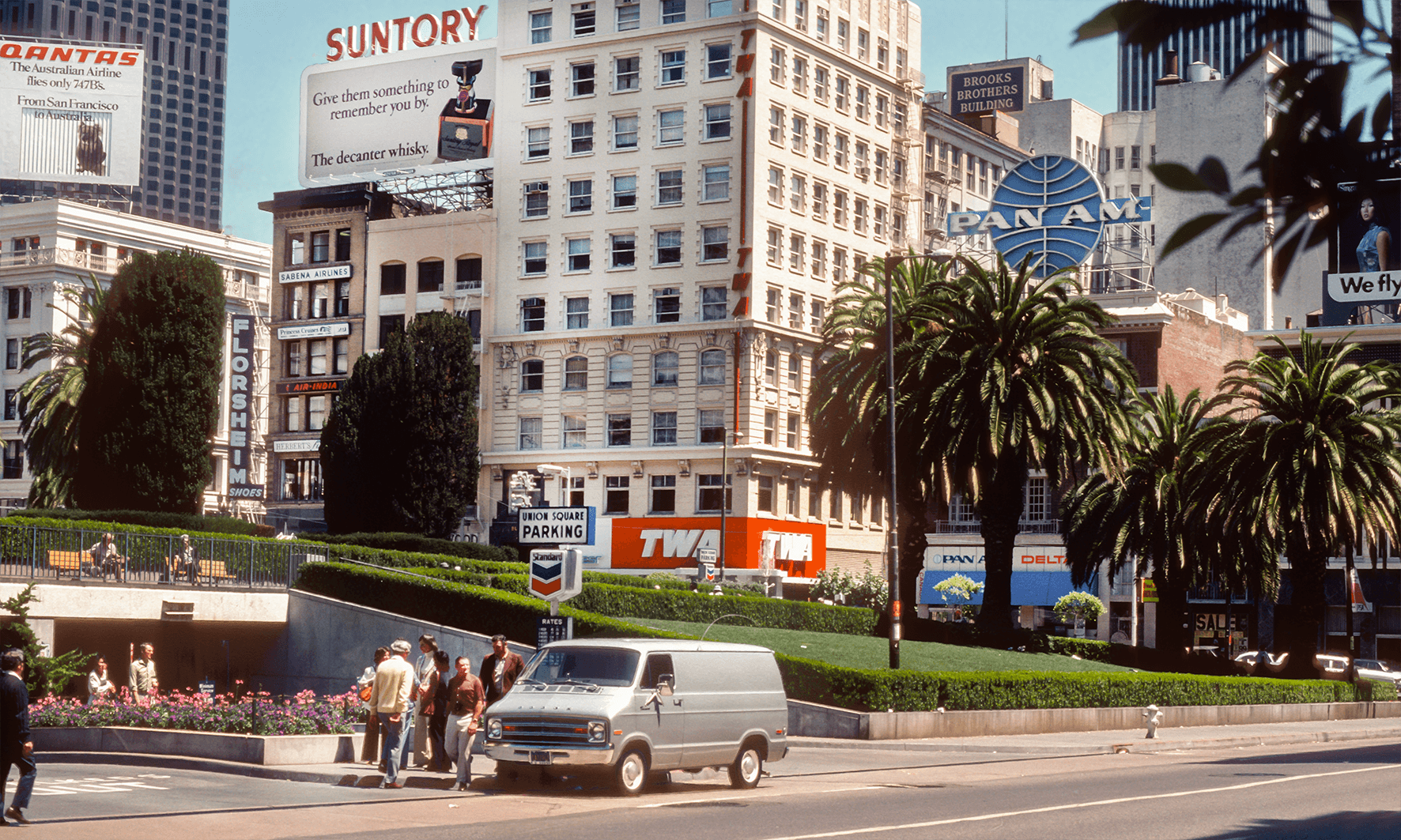
SF's busiest public gathering place Union Square back in the flamboyant ‘70s. And, clearly, airlines such as Pan Am and TWA made the dream of a European vacation a reality for many Americans who didn’t even know they wanted to take the so-called Grand Tour. For the airlines it served an important function, especially for foreign flag lines, which understood the value of having a visible presence in the centers of the major cities they served.

Popularised by Elvis Presley and greater airline connectivity, Hawaii and tiki-the islands were the most desirable destination in the United States to vacation. But sweeping cultural changes in the 1970s reshaped the airline industry that began offering also exceptionally inexpensive transatlantic flights. “All roads used to lead to Rome” ! Note the carrier signs on the left side of this roadview. Lufthansa; it was them that got the word out to make their 1972 campaign to stand out from the rest.

The sunlight falling down on the gigantic old Sequoia tree and lightens up the colors of bark and the leaves. The car stopping just before entering the tunnel, big car in an even bigger forest. A tunnel was cut through the tree by the Scribner brothers in 1881. The tree was 260 ft tall with a 28 ft base and about 2000 years old.
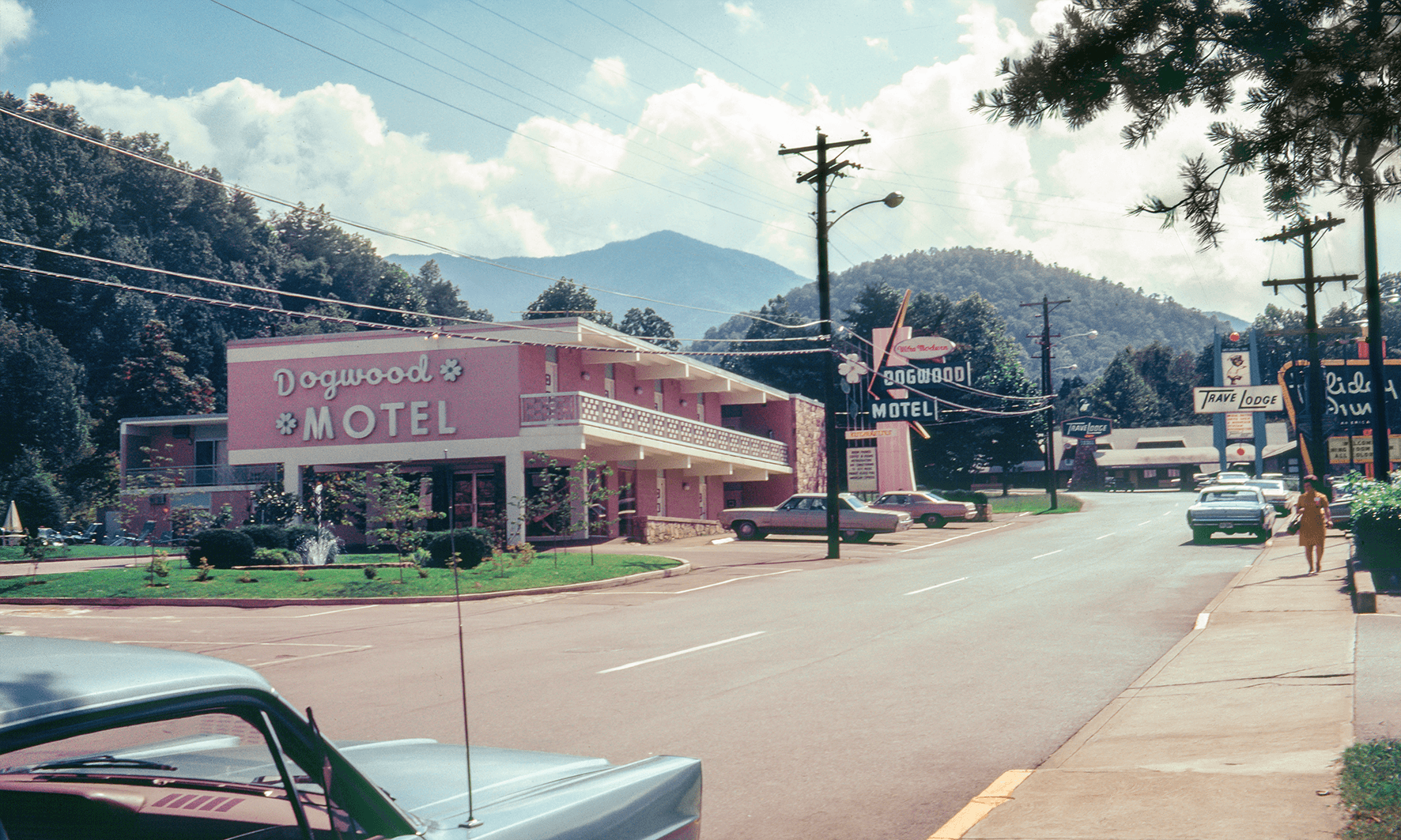
You’ve seen them in movies, motels, the classic roadside lodgings with big flashy neon signs, are the epitome of Americana culture. But what exactly is a motel and what is the difference between hotel and motel? Originally designed for motorists (the name ‘motel’ stems from ‘motor hotel’), motels are low-rise constructions typically found along motorways as opposed to hotels, favoring city centers. The layout of a motel is usually orientated to the outside, while hotels’ doors normally face an interior hallway.
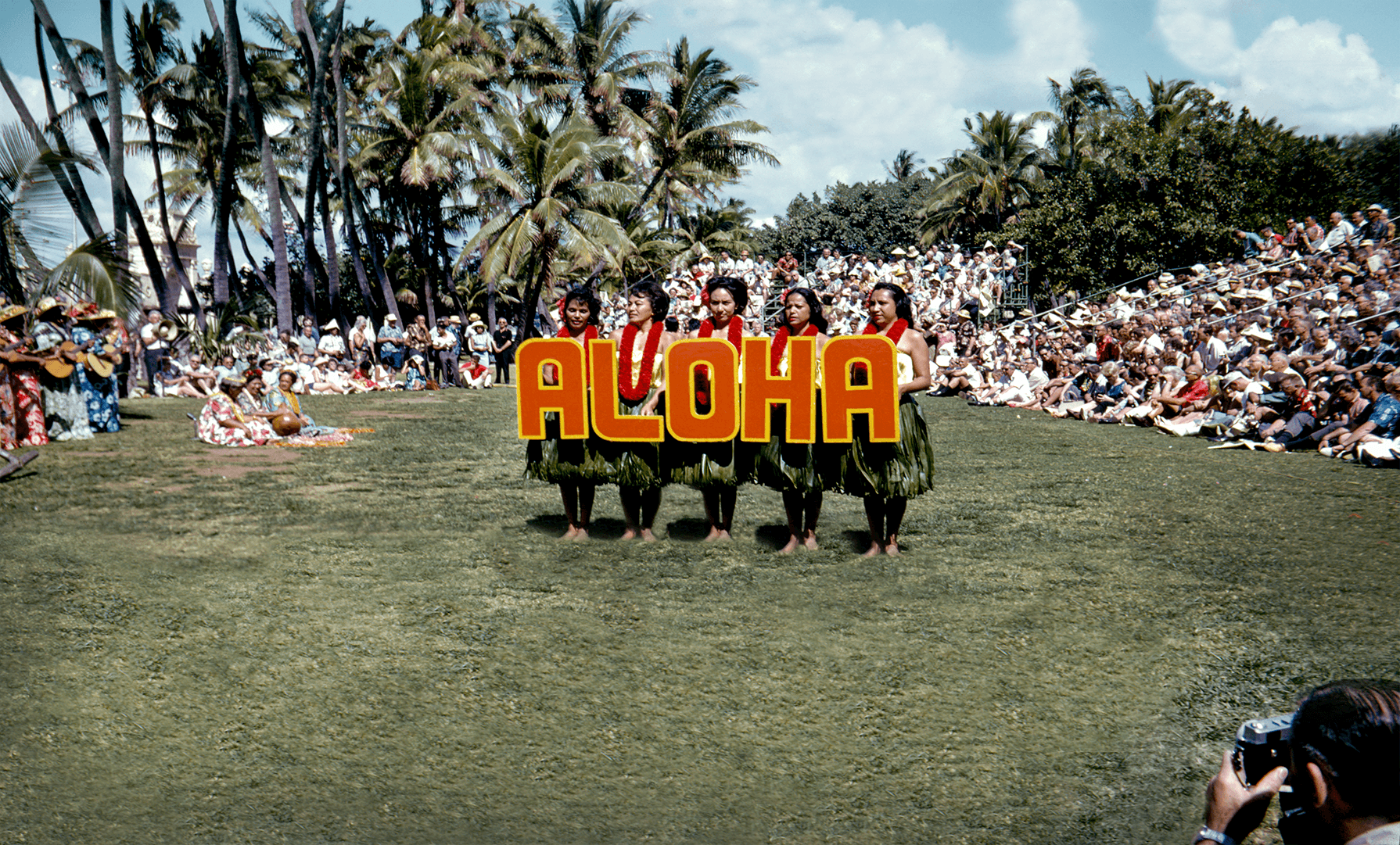
In the 1960s, Hawaii underwent a major growth spurt. After officially becoming a US state in 1959, a romanticized idea of Hawaii spread like wildfire, complete with tiki torches, bright aloha shirts and beautiful, tanned hula dancers swaying to lazy slack-key melodies. After all, who wouldn't want to visit "the nation's newest and most exotic state”.

Just because they were called Tradesman vans doesn’t mean they have to act like tradesmen. Far from it. In the early Seventies, after low-lead gas and rising insurance costs put the kibosh on the original muscle-car era, a number of car lovers turned their creative attention to vans. Free thinkers became vanners and the “cruising van” era lasted for most of the Seventies.
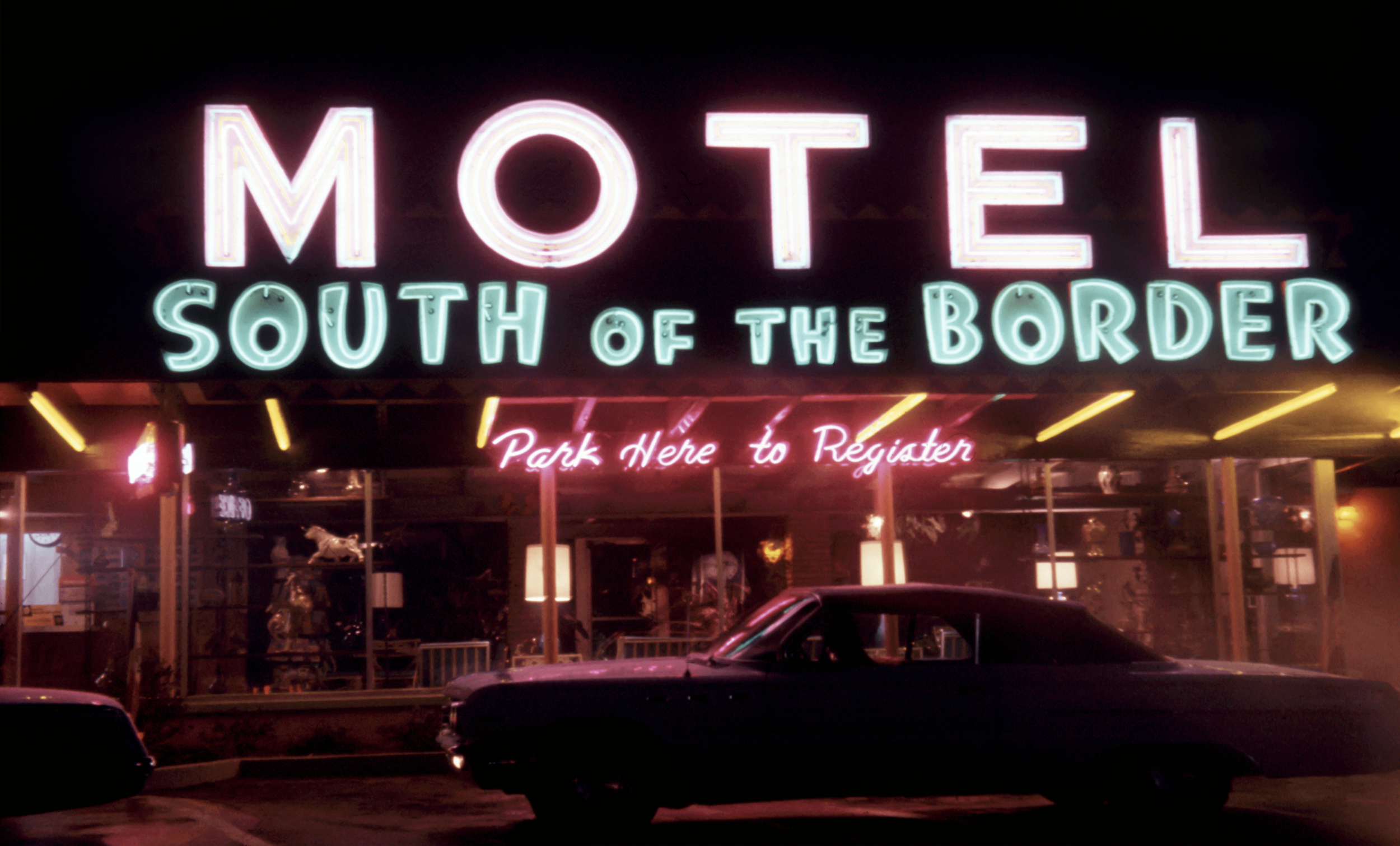
South of the Border motel was part of a caricatured road stop attraction built on a Mexican theme. Families parked their packed wood-paneled station wagons here looking to stretch their legs and add a little whimsey to their roadtrip in the hey days. The place South of the Border bring to mind the photography of William Eggleston, the cinematography of David Lynch, and the gas station art of Ed Ruscha.

The Governor’s Cup Weekend at the Milwaukee Mile during a late season stock car racing event. Back when racing was racing & where old race cars rule. Many other sports originated in ancient times or as variations of classic games, but stock car racing has uniquely American roots. Stock car racing was originally a competition between cars that hadn't been altered from their original factory build. But as times changed and technology advanced, the sport evolved.













































Summer traffic in the blooming era of international travel. The scores of beautiful foreign vehicles, the shadow of the palm tree on the road, the man crossing the zebra in his dashing red suit, it all looks so surreal in this scene.
A stylish convertible as it parked down a growing Palm tree farm that is located in the heart of the Coachella Valley. In the American West residents love landscaping with the palm, it is their icon of oasis in the desert and the nostalgic promise of better shores.
Before the 60s, if you wanted to see wild animals in their natural habitat, free from the confining cages of a local zoo, you had to travel to an exotic locale. That is, until a group of entrepreneurs had a grand idea; a drive-through zoo! Lion Country Safari proved that a family could have a great time sitting in the comfort of their car while viewing man eating-lions, graceful giraffes, and grumpy rhinos through the relative safety of an automobile windshield.
During the 1960’s and 1970’s, about 300 craft cooperatives were formed throughout the United States. The Co-operatives provided incentives to American Indian artists representing over several tribal nations for the preservation of their contemporary and traditional crafts & culture. Could this scene not been taken straight out of a Wes Anderson movie?
Panhandling bears lingered by the roadsides knowing people would stop and throw out food to them. Viewing grizzly bears and American black bears from roadways became as popular than geyser watching in Yellowstone National Park.
Motel signs...they don't make them like they used to. And according to this sign, direct-dial phones and air conditioned rooms are among the amenities that probably seemed a lot more impressive back then. Vintage motel signs, from east to west and everywhere in between. America’s love affair with the road.
Situated near the intersection of Centerville Road and “The Wildcat”, the mountainous road to the Bear and Mattole River Valleys, Ferndale has been the location where film cameras roll to the call of “Action!”. When a Dr Pepper commercial was filmed here on Main Street in the late 1970s, many locals were hired to dance and sing, “I’m a Pepper. You’re a Pepper.” Even some of the town dogs were “Peppers.”
The 1970s became a defining decade for downtown Las Vegas. The Golden Nugget located at Fremont Street added its marquee styled facade and 'bull-nose' entrance. In the James Bond film Diamonds Are Forever the casino can be continually seen in the police chase scene.
Old West pioneer settlers resting on their journey, curious Indians peering from cover. An animated waterfall. The title above read..."Dedicated in all Humility to Those who Blazed the trail." The Harolds Club facade was sculptured by Sargent Claude Johnson.
In the heyday of the casino culture, the showgirl was the living symbol of Reno’s elegance. They were put up on a pedestal as an iconic thing and one casino even had a showgirl theme. The Primadonna became a real trendsetter with its bold colors, flamboyant decorations and the famous exterior with the five showgirl statues on the facade.
Avant-garde defined Casino signage that grooves in flashy red. It feels like the swinging sixties and I wonder if the front face design of the place is Art Deco influenced. The Horsehoe Club on Virginia Street opened in 1956 promising “Fun, Food and Fortune”. Reno known as "The Biggest Little City in the World", became world famous for its casinos.
“The Biggest Little City in the World" founded during California's gold rush and first to reach prominence as a gaming center. Unfortunately it became a victim of popular culture during the mid 1960s. Acts like The Rat Pack and Elvis Presley began calling Las Vegas their home. Now, not only could people stop in at Sin City to partake in otherwise questionable behavior while receiving their gambling fix, but also being personally serenaded by Frank Sinatra in the process. Reno didn’t stand a chance.
Zabriskie Point is the lowest point in the North American continent, a part of Death Valley. In the past it was possible to drive right to the edge of the overlook of a huge area of yellow-brown-black badlands, with the white salt flats in the main valley beyond. An 1970 American drama film directed by Michelangelo Antonioni was shot here and to some extent achieved cult status.
Built on 328 acres of farmland five miles northwest of Indianapolis, Indiana, the speedway was started by local businessmen as a testing facility for Indiana’s growing automobile industry. The idea was that occasional races at the track would pit cars from different manufacturers against each other. After seeing what these cars could do, spectators would presumably head down to the showroom of their choice to get a closer look.
Visit this bank without getting out of your car. Drive-through teller stations, once promoted as a convenience for the after-work crowd wanting to keep Bob Dylan songs playing while depositing their paychecks. Drive-throughs have generally replaced drive-ins in popular culture, and are now found in the vast majority of modern American fast-food chains. It was 1975 when the first McDonald's drive-through was created in the U.S.
Stylish cars driving around the valley of the famous Camelback Mountain, the palm trees rising on either side like tall and thin, pillars of towering opulence, it feels like the icons of a bygone age.
An old-fashioned community parade, spectators line the streets keeping them enthralled for hours. Sparkle and shine, a teenage girls marching band performs developed and harmonized arrangements of music, a sense of nostalgia and pride here from the 70’s.
A motel nestled in the picturesque village of June Lake. Colorful granite peaks rise above the lakes and village where local waterfalls are reminiscent of Yosemite. Glacial moraines frame the Loop. The crystal blue waters of June Lake and the road overlooking it have been popularized in numerous car commercials. In Fall, the turning and flaming colors of the thick aspen groves feels like we’re in the Twin Peaks universe.
High in the Rocky Mountains and once a booming gold mining centre, Virginia City during spring. It is the wild west again, tourist style 1975. Be careful staying at the Fairweather Inn. Rumor has it that it is home to some ghostly children, witnesses described footsteps, whispers, the rustling of old-fashioned dresses, and doors that opened and closed on their own. The film The Missouri Breaks was partly filmed in Virginia City.
A crowd dressed up for a Motown concert at Cobo Hall. Detroit took on the nickname "Motor City" recognized as the heart of the American automotive industry. In tribute to what Motown's founder Gordy felt was the down-home quality of warm, soulful people he grew up around, used “town” in place of “city”, which gave him the contraction “Motor Town” and the perfect name for his company and the label Motown.
It's the bus queue that is often cited as an example of the demise of civilised queuing. In some places it's every man, woman and child for themselves when the bus draws up. Clear evidence the orderly queue seems to have been an established social form in Detroit. You would think a product of more urbanised, industrial societies which brought masses of people together.
Young man, there’s a place you can go. I said, young man, when you’re short on your dough. You can stay there, and I’m sure you will find. Many ways to have a good time. It’s fun to stay at the Y-M-C-A. It’s fun to stay at the Y-M-C-A.”
The Steelers and Cowboys met in Superbowl X. When those fans close their eyes today and picture the ideal football team, they cannot help but picture the mid-'70s Steelers, clad in all black, galloping in NFL Films slo-mo, beating opponents with brutal determination. The Steelers did win and it was remembered for being the most exciting of the first 10 Super Bowl games in history.
Lower, wider, and longer is how Detroit made cars in the '60s, and this 1966 Ford Galaxie 500 coupe is arguably the best way to show that off. The people at Ford placed the headlights and taillights as far in the corners of the body as possible. That way everything looked stretched to the max. This allowed for some seriously large chrome elements. It's hard not to love the mid-60s Galaxies.
When we look back on the artistic accomplishments of the mid 20th century, many times we neglect the significance of the geodesic dome. This gymnasium is a Buckminster Fuller-Inspired Gold Dome and opened officially in 1977 in Newark. Not only was this design original, but it served as a symbol of the modern impulse of glorifying technology and science.
New York's streets are constantly changing to reflect the dreams of each new era, and perhaps none has evolved more dramatically than 42nd Street. During its heyday in the 1960s and ‘70s, the block of 42nd Street between Seventh and Eighth Avenues was know as "the Deuce". Theaters may fill Times Square today, but they're a far cry from the movie palaces that once populated in this neighborhood.
It was a local entrepreneur Clarke Sanford that had this art-deco style theater built. Sanford brought 20th-century invention, the movies, to Margaretville in the Catskills. The theater was named after opera star Amelita Galli-Curci, whose Sul Monte estate was in nearby Highmount, if she sang at opening night in 1922, which she did, closing with "Home! Sweet Home!".
Now that's a wall of sound! Schmitt music centers chose notes from a musical score that could be painted as a mural over the enormous facade. After completion Minnesota-born artist known as Prince famously posed in front of this mural in 1977. The portrait of the young Prince was taken at the age of 19 years old and it became his first professional photo shoot, one of his most iconic images.
Located at Coney Island this wooden roller coaster, the Thunderbolt, was featured in Woody Allen's 1977 film Annie Hall. One of the coaster’s most famous aspects had nothing to with the ride it gave, but with the house that sat under the first and third turns. The family that lived in the house used to find teeth, wigs, glasses, guns in the yard. Everything they found in the yard…according to the story, nobody came back for them, though.
Passing the backside of Wintergarden, the theatre on Broadway carries classic and contemporary musical posters. The 1970s proved to be a great time for change and growth on Broadway with movie musicals that saw a rise following the success of Grease, both on stage and off. Fiddler on the Roof held the record for the longest-running Broadway musical for almost 10 years until Grease surpassed its run.
The Miami-Ft. Lauderdale area is known for many things. Sparkling beaches. Gorgeous weather. Nude sunbathers. Also, scores of beautiful foreign vehicles, daily-driven luxe and brightly-colored exotics. With all the plush droptops and scissor-doored goodness you’ll see cruising down the strip in South Beach these days, it’s easy to lose that enduring appeal of American Metal.
We tuck inside the Rocky Mountains, end of day and time for a beer. Budweiser, king of the beers apparently served everywhere. This quaint little town known as Silverton has roots in mining, half of Colorado's gold production in the 1970s came from the Sunnyside mine situated northeast of Silverton. The tiny settlement is an incorporated municipality with roughly over 530 residents.
Apart from the beautiful foreign vehicles, this picture draws us into the kid on the bike. A type of stylized children's bicycle designed with the banana seat, as it came to be known. They were first produced in 1963 and together with the high-rise handlebars it gets the look of a "chopper" motorcycle. It was an instant hit among teenagers back then.
Four gigantic faces carved into a mountain hillside. It took 14 years to carve four sculptures of famous American presidents into the granite face of the mountain. George Washington, Abraham Lincoln, Thomas Jefferson and Theodore Roosevelt. Mount Rushmore became an iconic symbol of the United States while it appeared in works of fiction, as well as being discussed or depicted in other popular works.
Against the backdrop of two mountain ranges, the Grand Tetons and Gros Ventres, the Jackson hole valley here pictured during the mid seventies. A majestic escape that brings to mind the nostalgia of Western movies coupled with the untamed beauty of the wilderness. Even more current is "Django Unchained”, Quentin Tarantino's spaghetti western shows off the Teton range and even a scene with Jamie Foxx taking a soak in Kelly Warm Springs.
This welcome sign was on U.S. 66 after entering Arizona from California. Greeting the traveler entering The Land of Sunshine and a the state of contrast. While mountains tower over a mile high; the rivers have cut miles deep into the earth. Modern planes fly over Indian lands where people live as they did hundreds of years ago.
In the summer of 1967, the perfect storm of the Sixties revolution was beginning to rumble. The escalation of the Vietnam War and the resistance to the draft, combined with the black power movement and the psychedelic-fueled counterculture, would soon cause a nation-wide spontaneous combustion. Here 60,000 marched in San Francisco. Up to its time, the Spring Mobilization to End the War in Vietnam was the largest antiwar demonstration in U.S. history.
SF's busiest public gathering place Union Square back in the flamboyant ‘70s. And, clearly, airlines such as Pan Am and TWA made the dream of a European vacation a reality for many Americans who didn’t even know they wanted to take the so-called Grand Tour. For the airlines it served an important function, especially for foreign flag lines, which understood the value of having a visible presence in the centers of the major cities they served.
Popularised by Elvis Presley and greater airline connectivity, Hawaii and tiki-the islands were the most desirable destination in the United States to vacation. But sweeping cultural changes in the 1970s reshaped the airline industry that began offering also exceptionally inexpensive transatlantic flights. “All roads used to lead to Rome” ! Note the carrier signs on the left side of this roadview. Lufthansa; it was them that got the word out to make their 1972 campaign to stand out from the rest.
The sunlight falling down on the gigantic old Sequoia tree and lightens up the colors of bark and the leaves. The car stopping just before entering the tunnel, big car in an even bigger forest. A tunnel was cut through the tree by the Scribner brothers in 1881. The tree was 260 ft tall with a 28 ft base and about 2000 years old.
You’ve seen them in movies, motels, the classic roadside lodgings with big flashy neon signs, are the epitome of Americana culture. But what exactly is a motel and what is the difference between hotel and motel? Originally designed for motorists (the name ‘motel’ stems from ‘motor hotel’), motels are low-rise constructions typically found along motorways as opposed to hotels, favoring city centers. The layout of a motel is usually orientated to the outside, while hotels’ doors normally face an interior hallway.
In the 1960s, Hawaii underwent a major growth spurt. After officially becoming a US state in 1959, a romanticized idea of Hawaii spread like wildfire, complete with tiki torches, bright aloha shirts and beautiful, tanned hula dancers swaying to lazy slack-key melodies. After all, who wouldn't want to visit "the nation's newest and most exotic state”.
Just because they were called Tradesman vans doesn’t mean they have to act like tradesmen. Far from it. In the early Seventies, after low-lead gas and rising insurance costs put the kibosh on the original muscle-car era, a number of car lovers turned their creative attention to vans. Free thinkers became vanners and the “cruising van” era lasted for most of the Seventies.
South of the Border motel was part of a caricatured road stop attraction built on a Mexican theme. Families parked their packed wood-paneled station wagons here looking to stretch their legs and add a little whimsey to their roadtrip in the hey days. The place South of the Border bring to mind the photography of William Eggleston, the cinematography of David Lynch, and the gas station art of Ed Ruscha.
The Governor’s Cup Weekend at the Milwaukee Mile during a late season stock car racing event. Back when racing was racing & where old race cars rule. Many other sports originated in ancient times or as variations of classic games, but stock car racing has uniquely American roots. Stock car racing was originally a competition between cars that hadn't been altered from their original factory build. But as times changed and technology advanced, the sport evolved.
